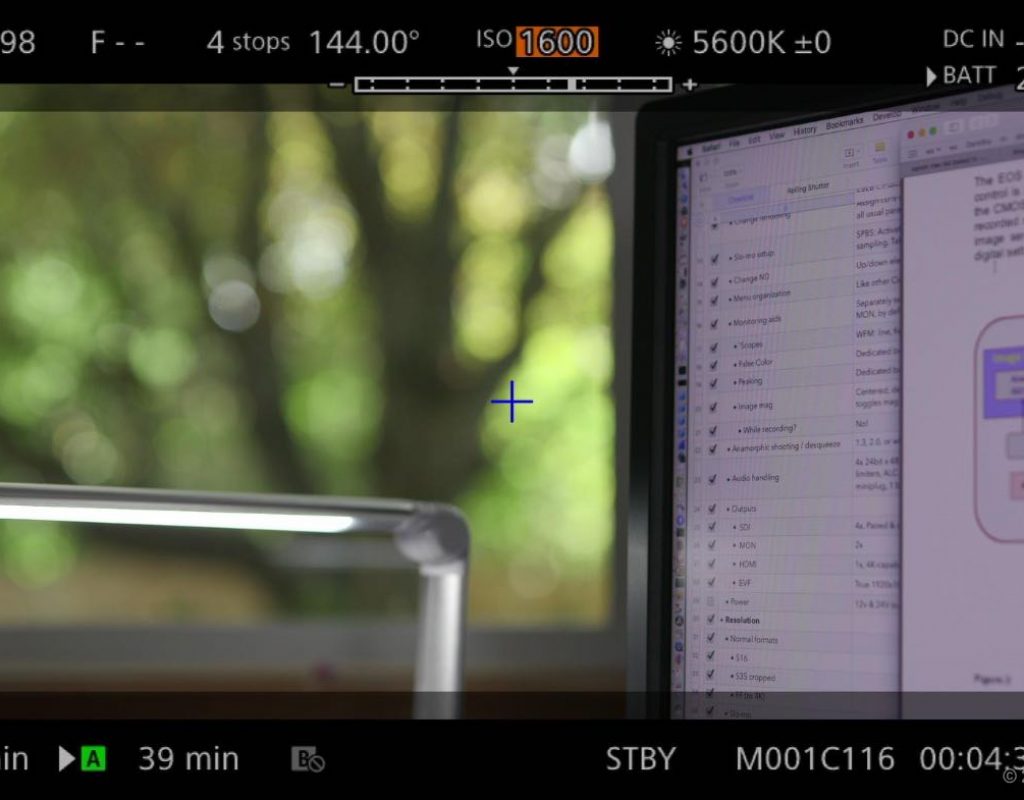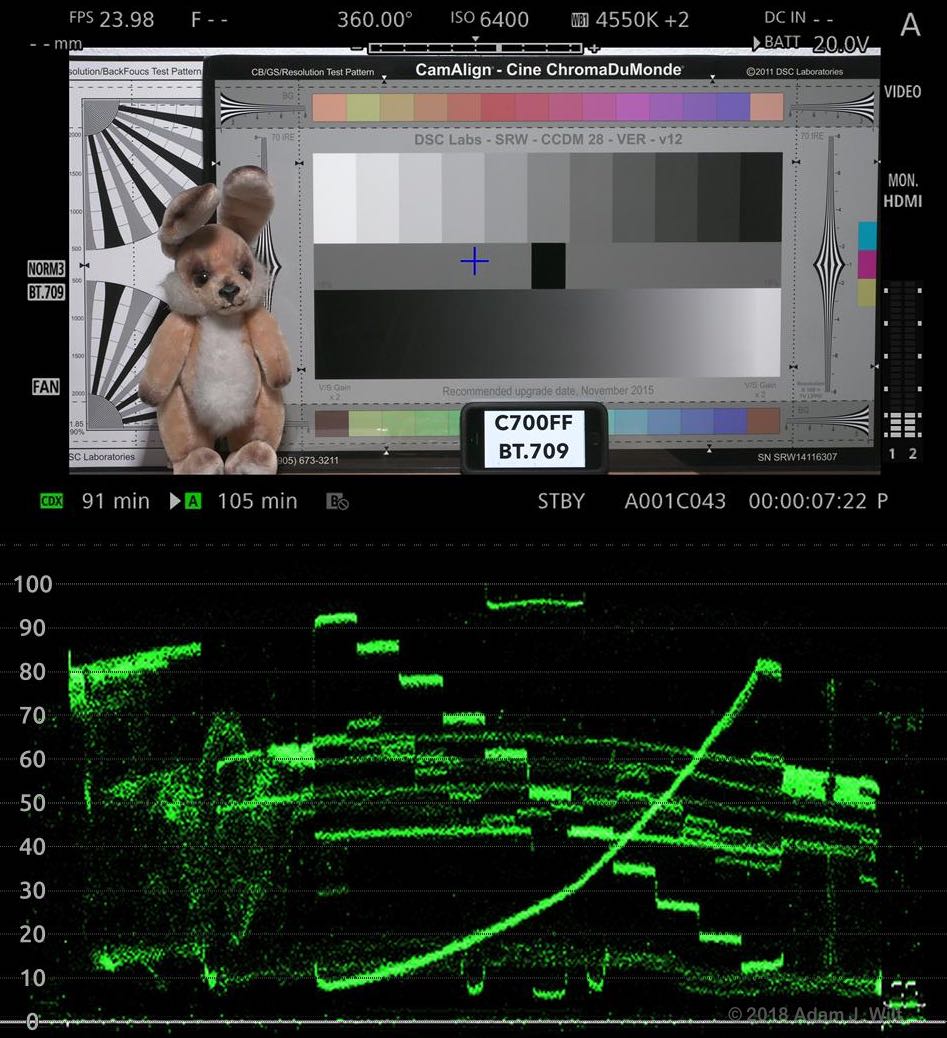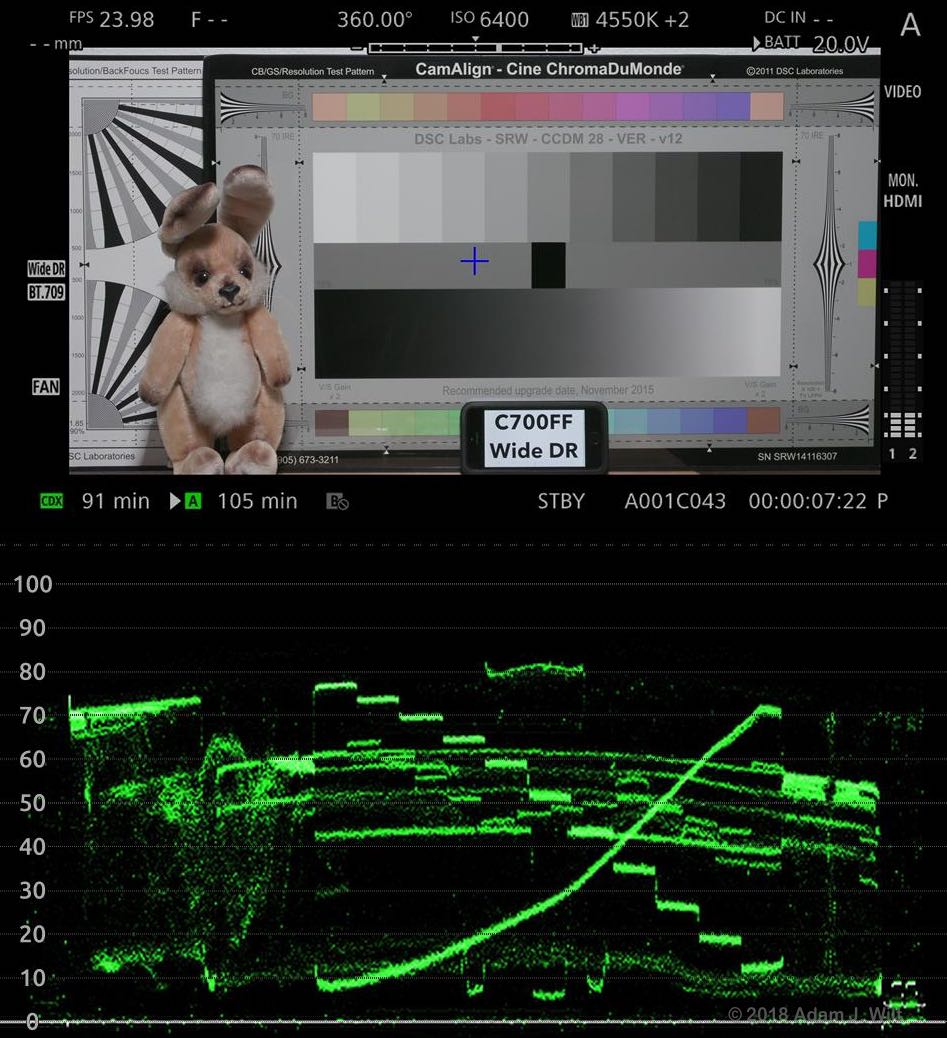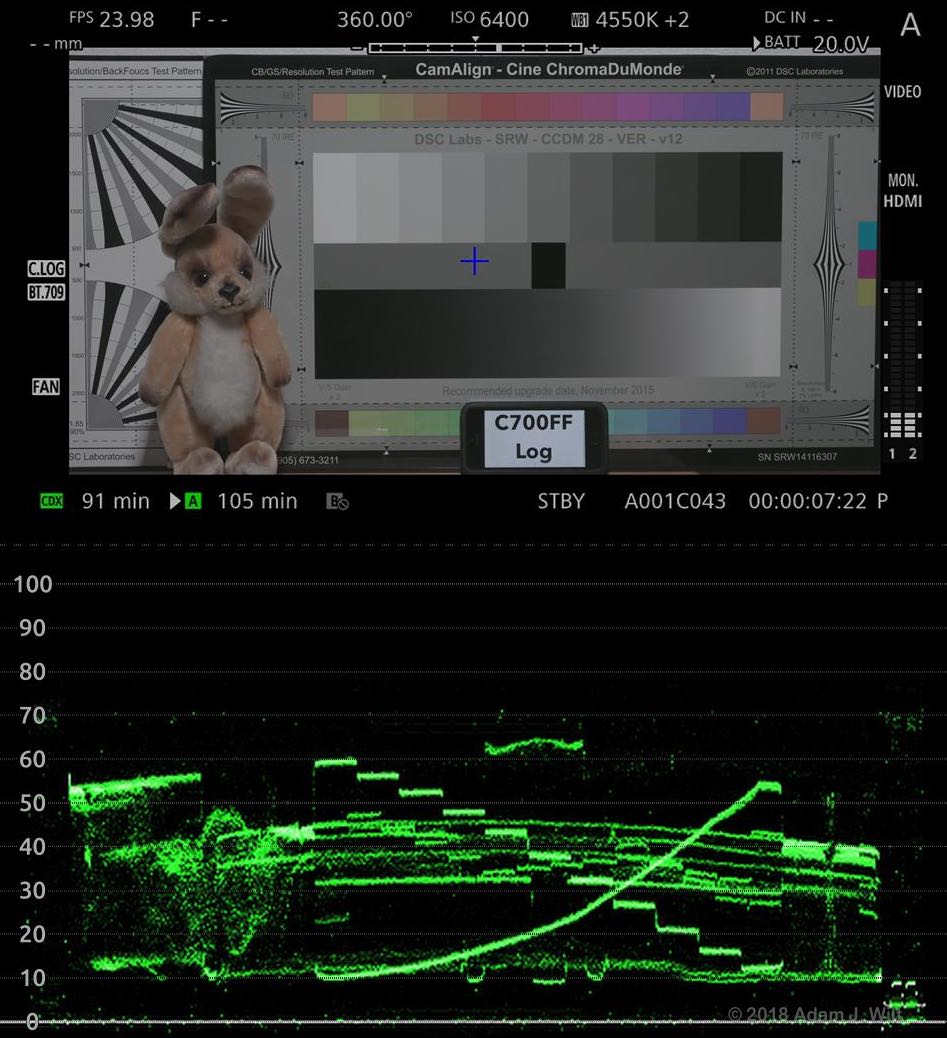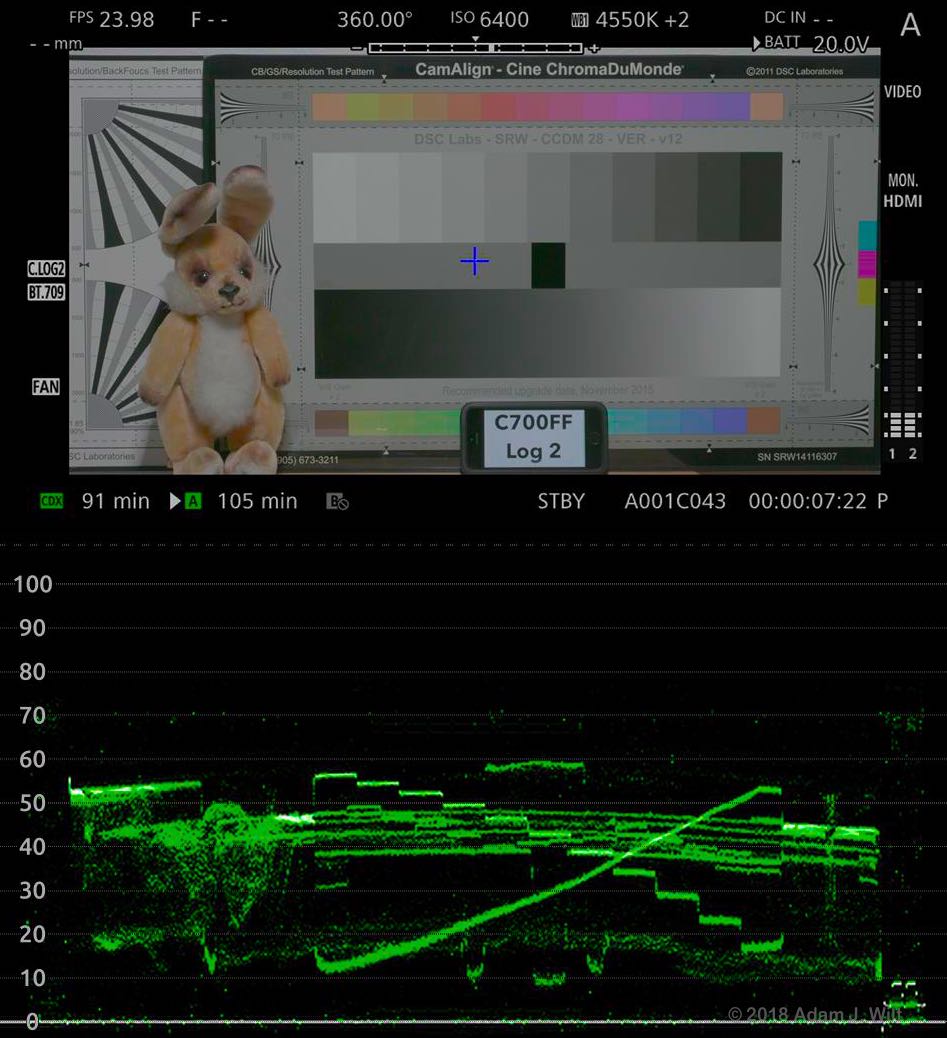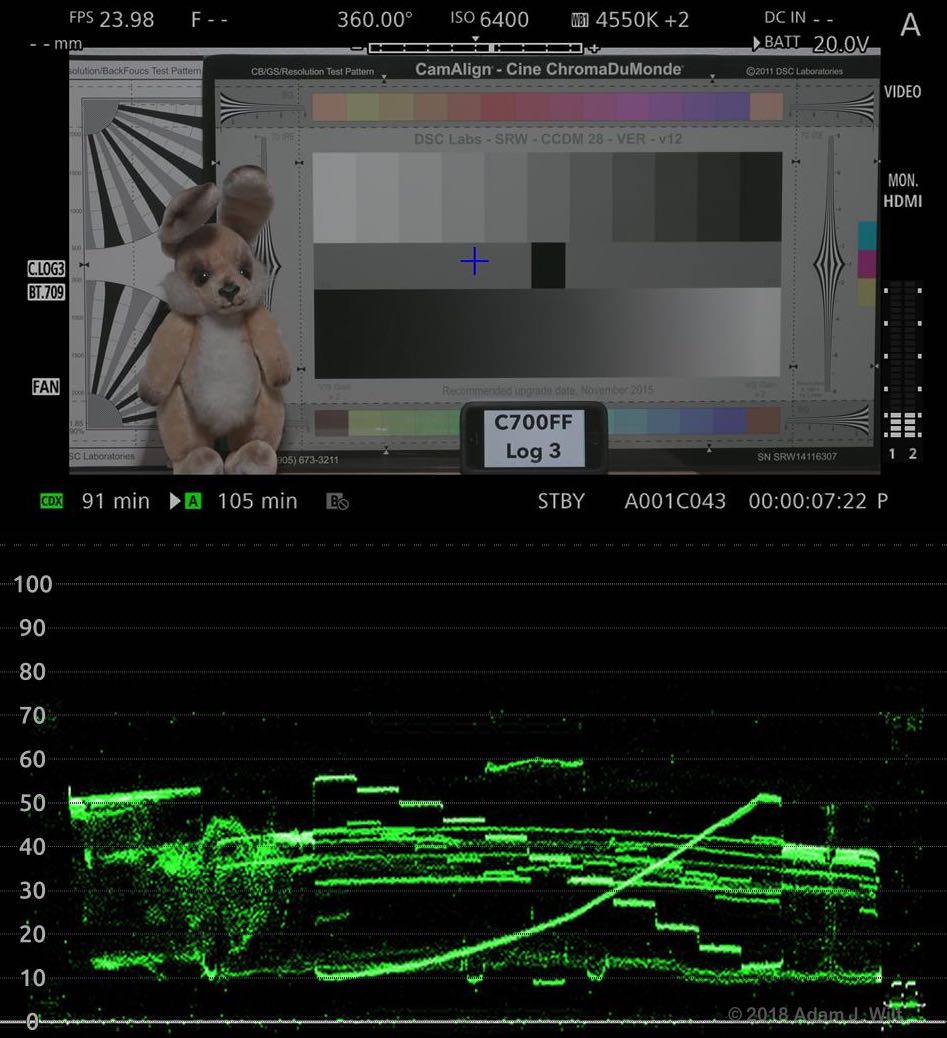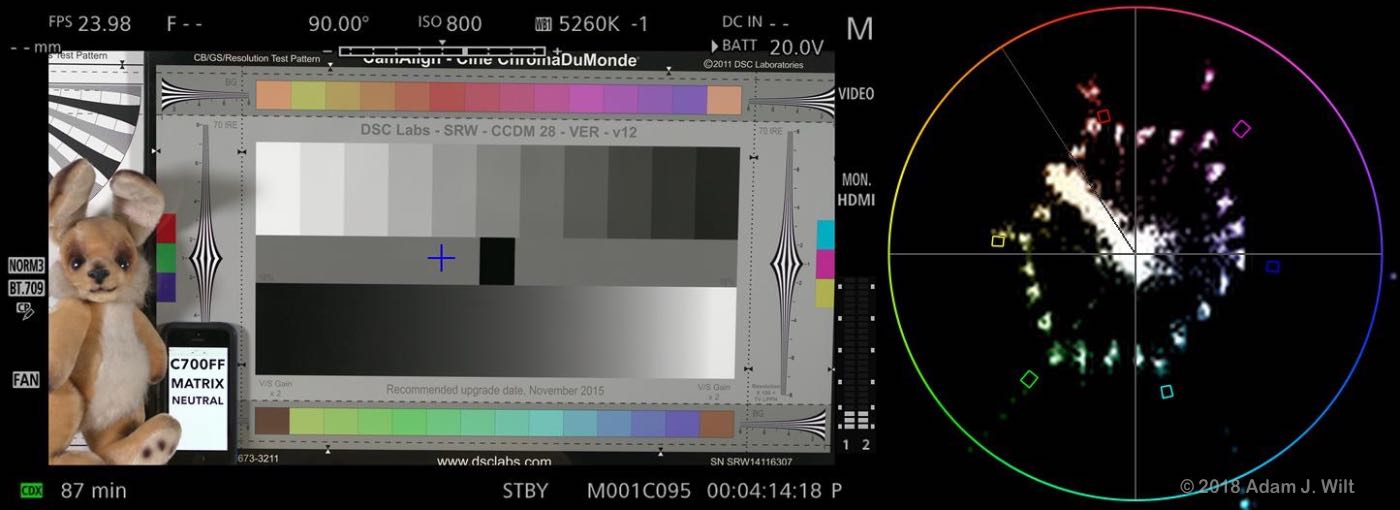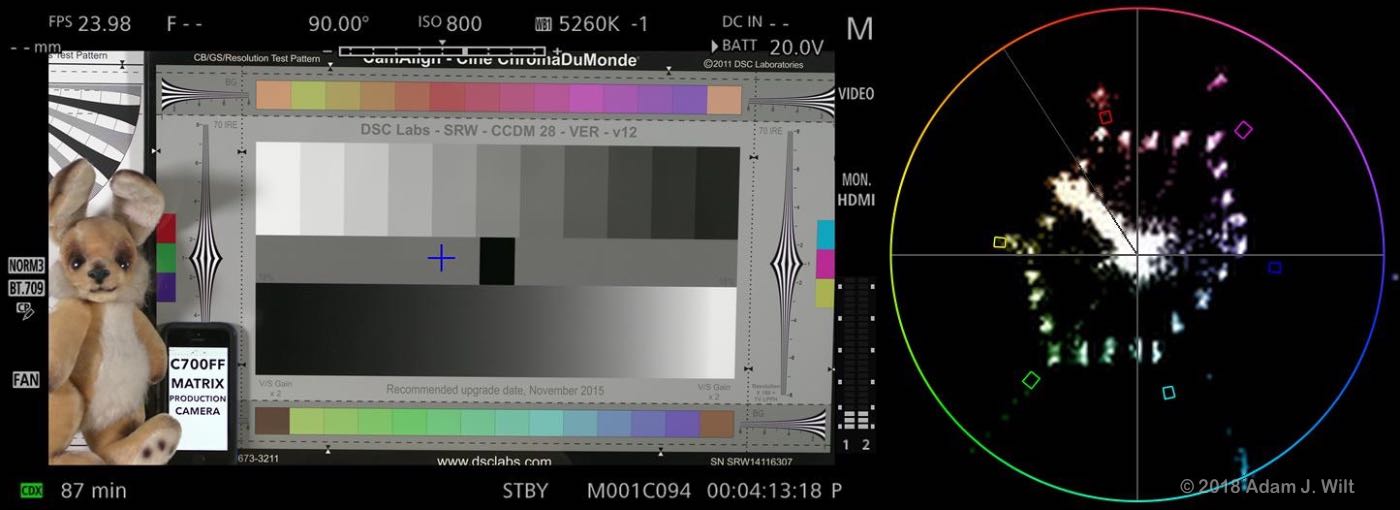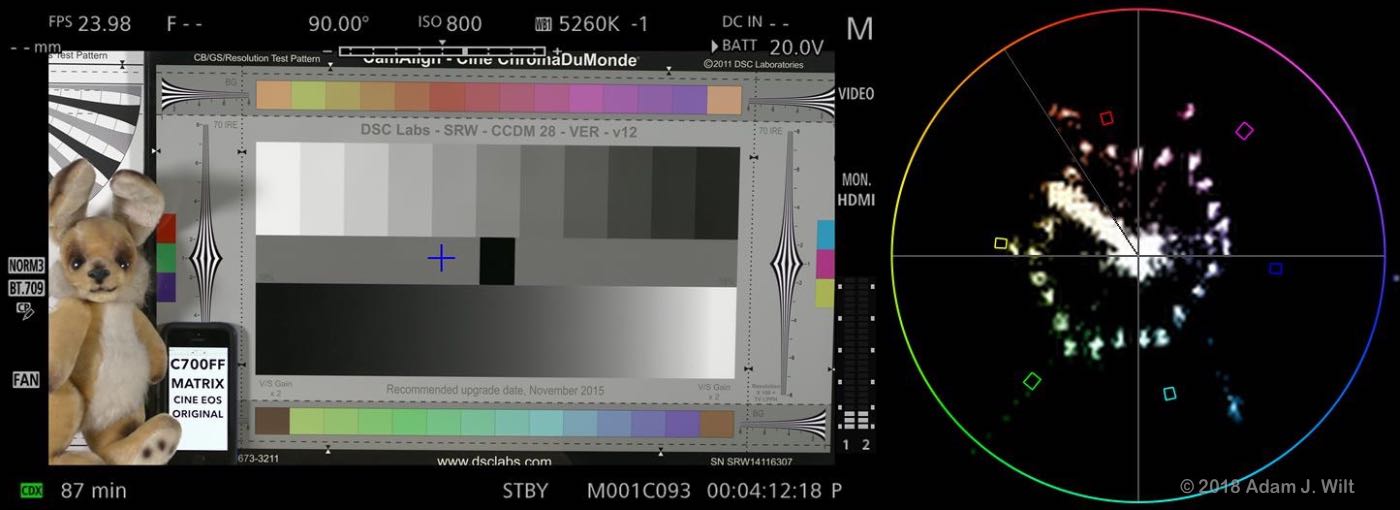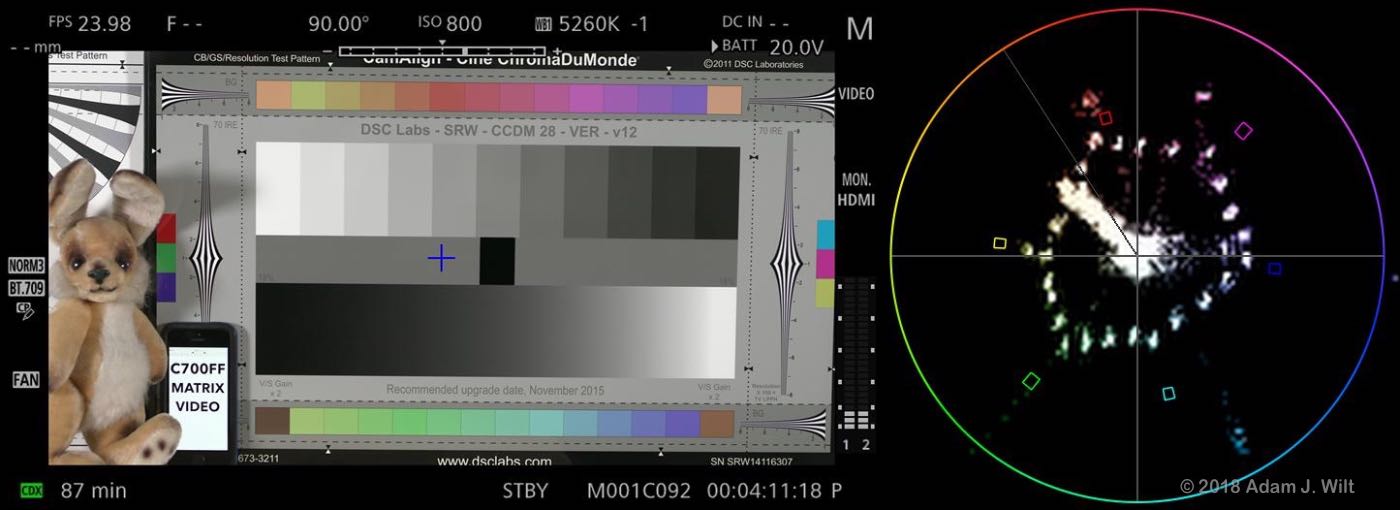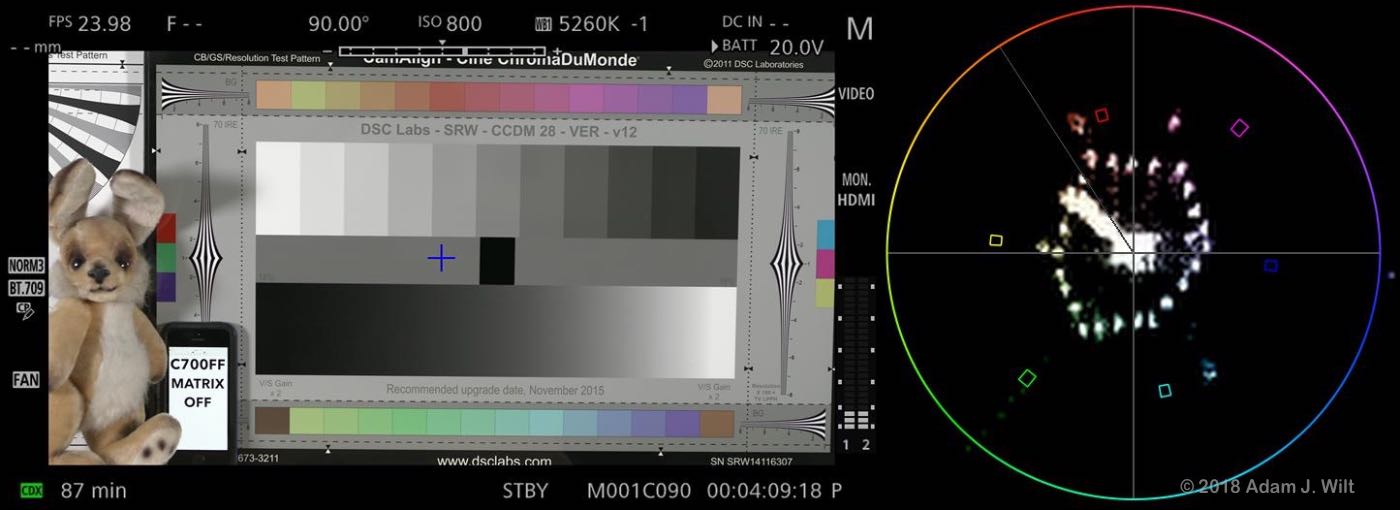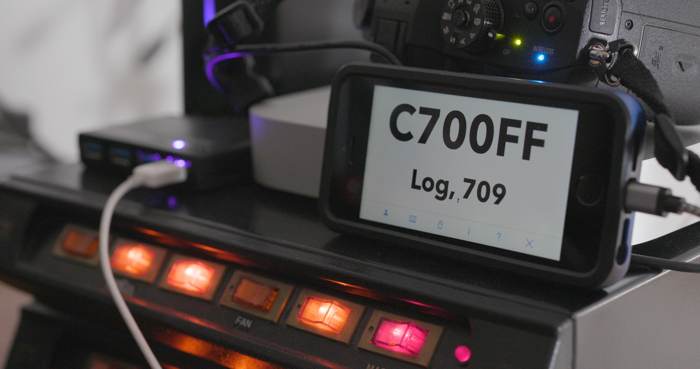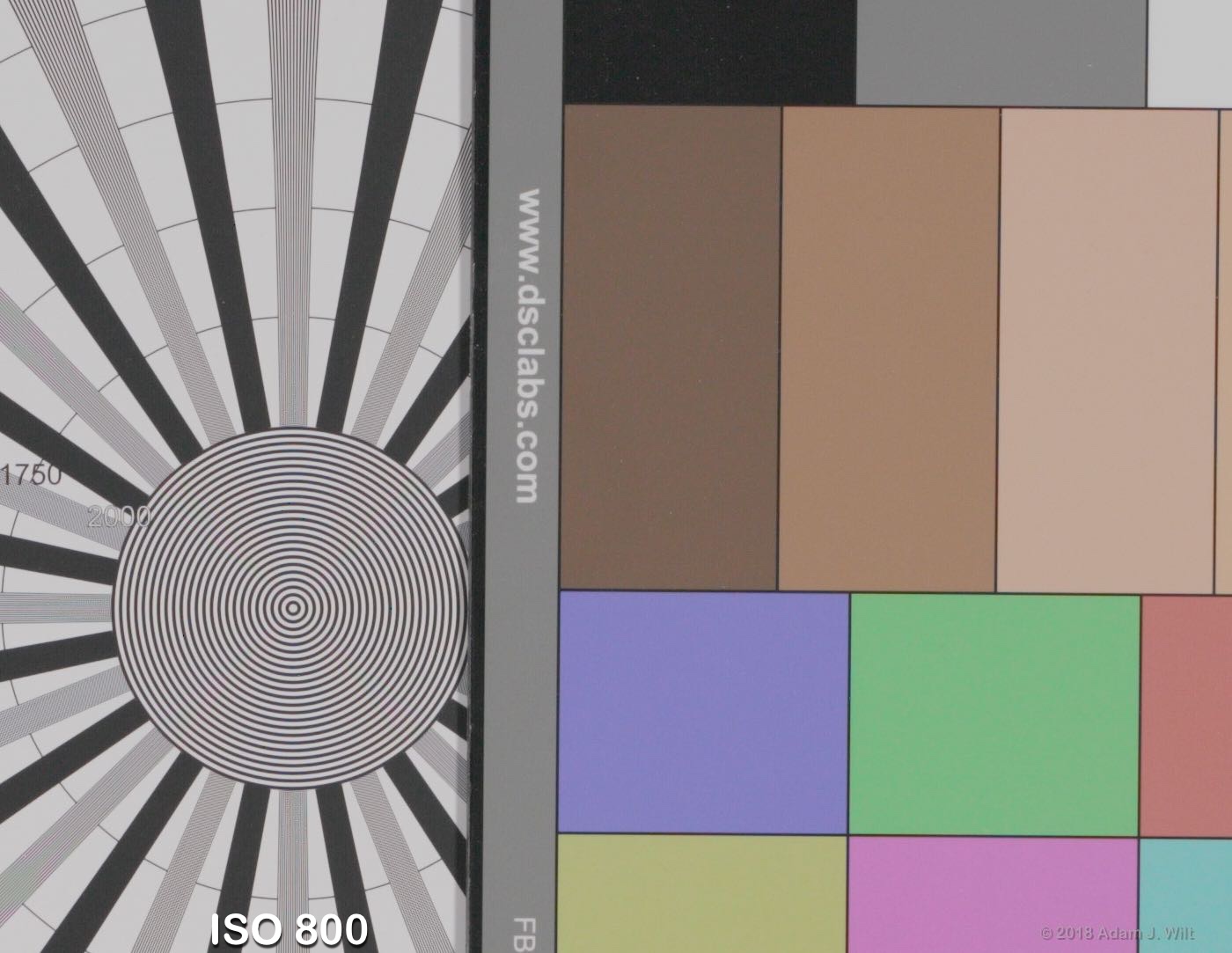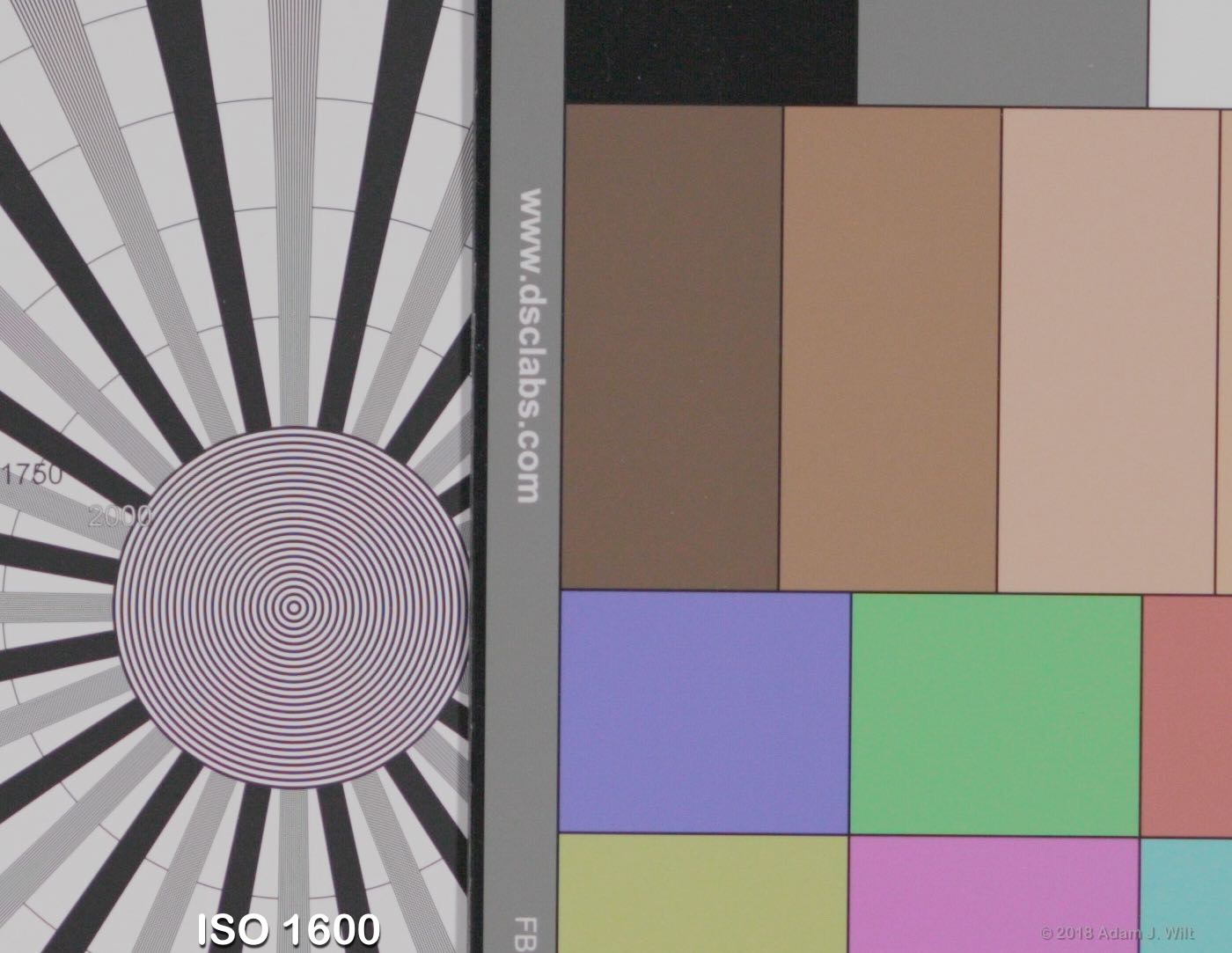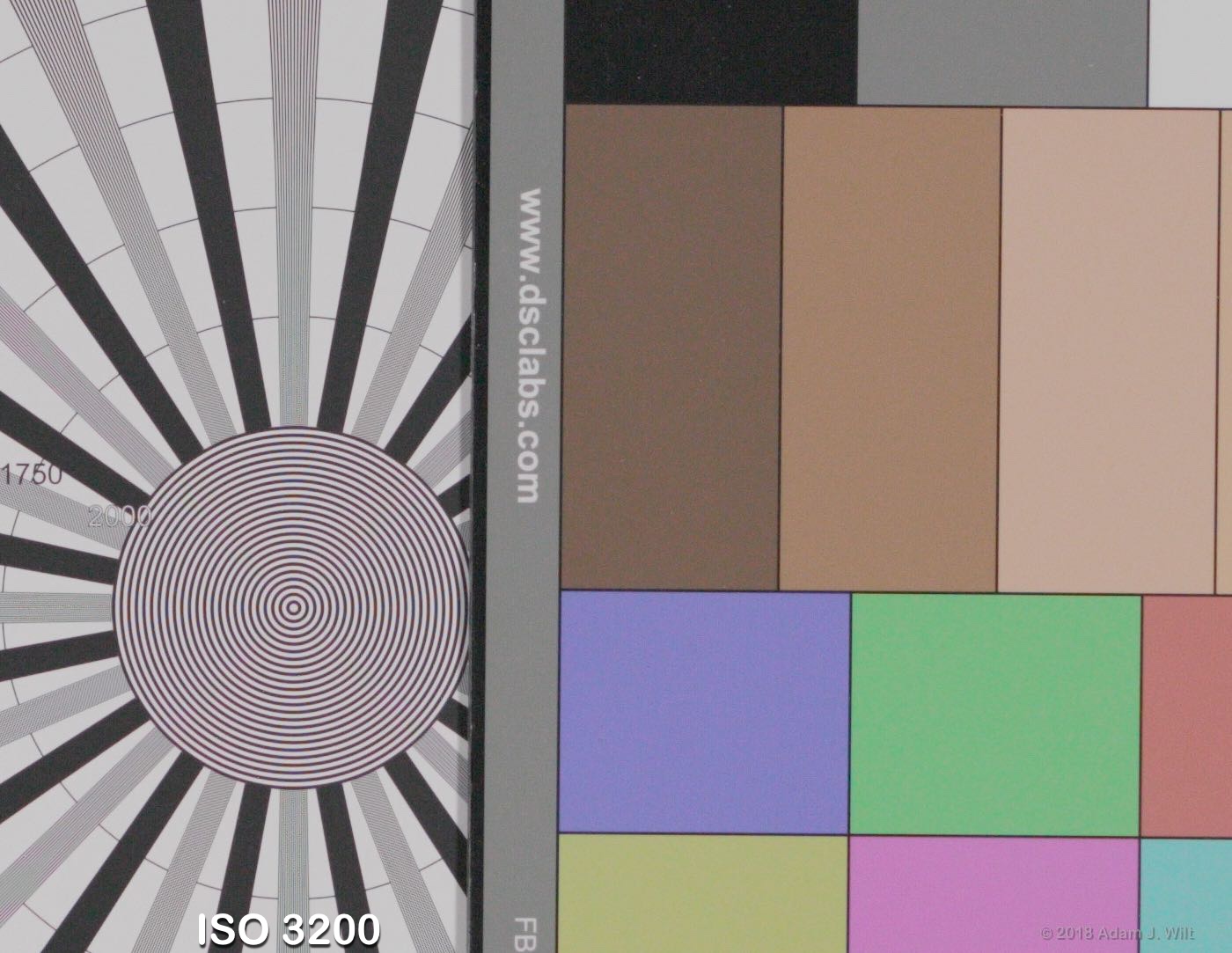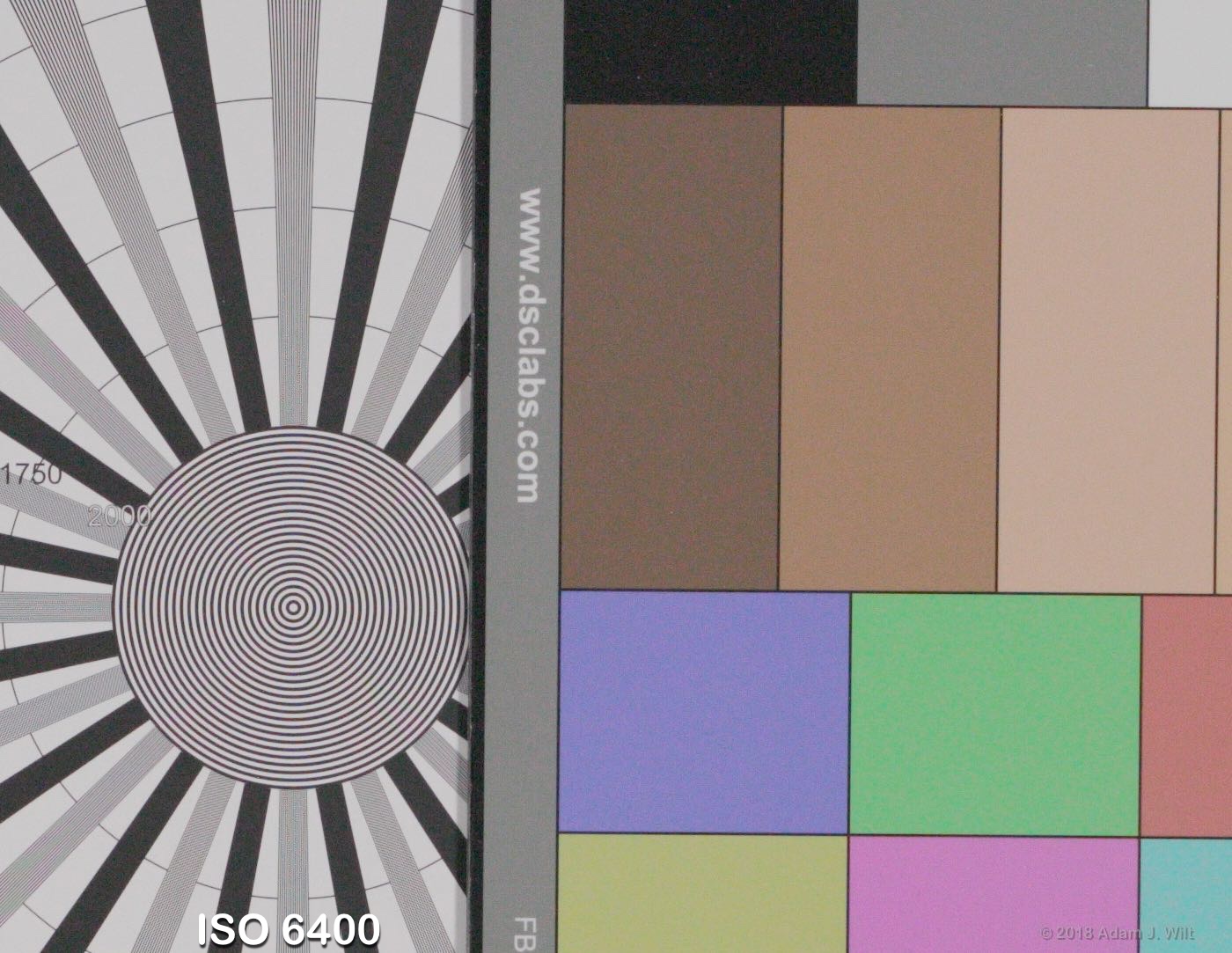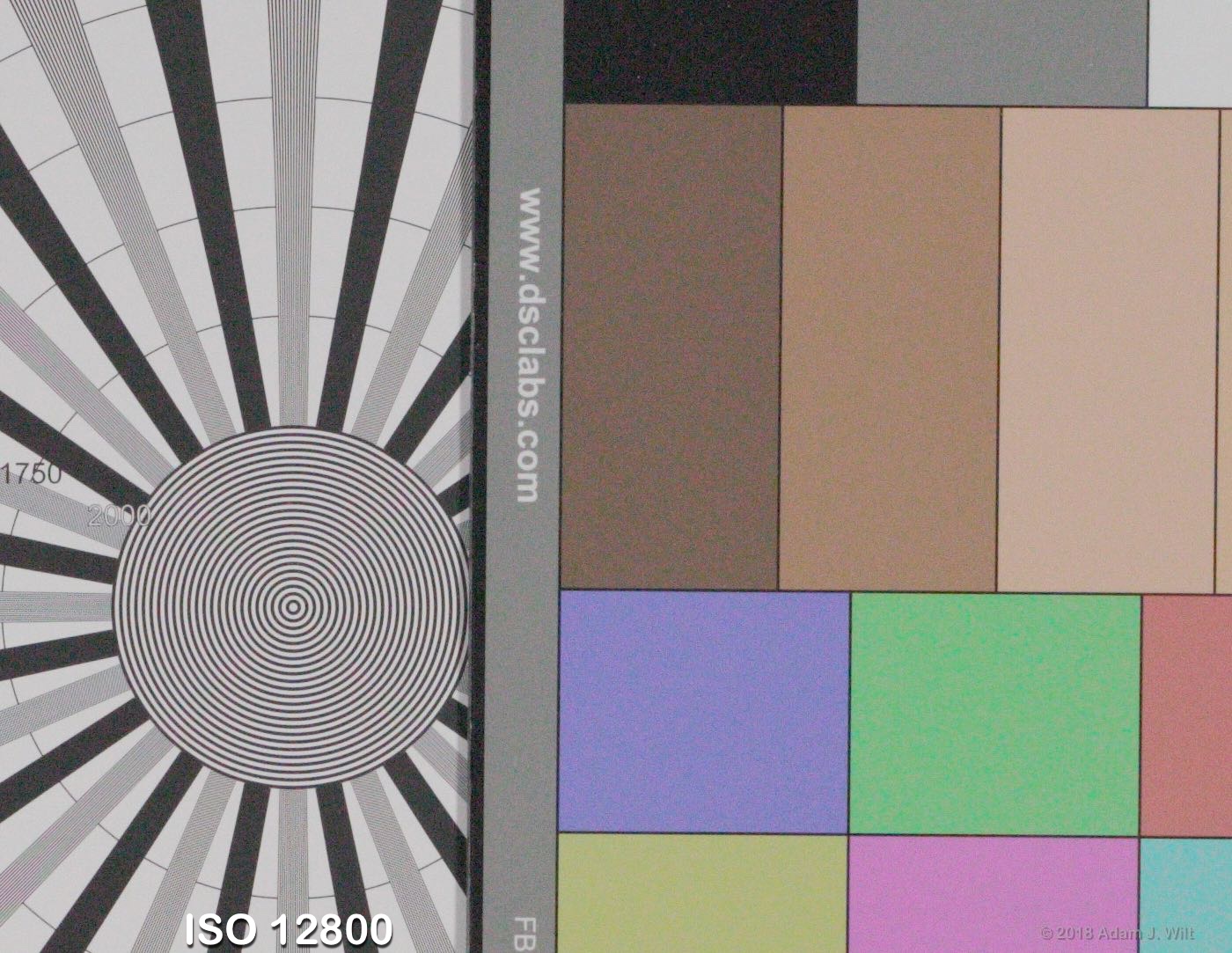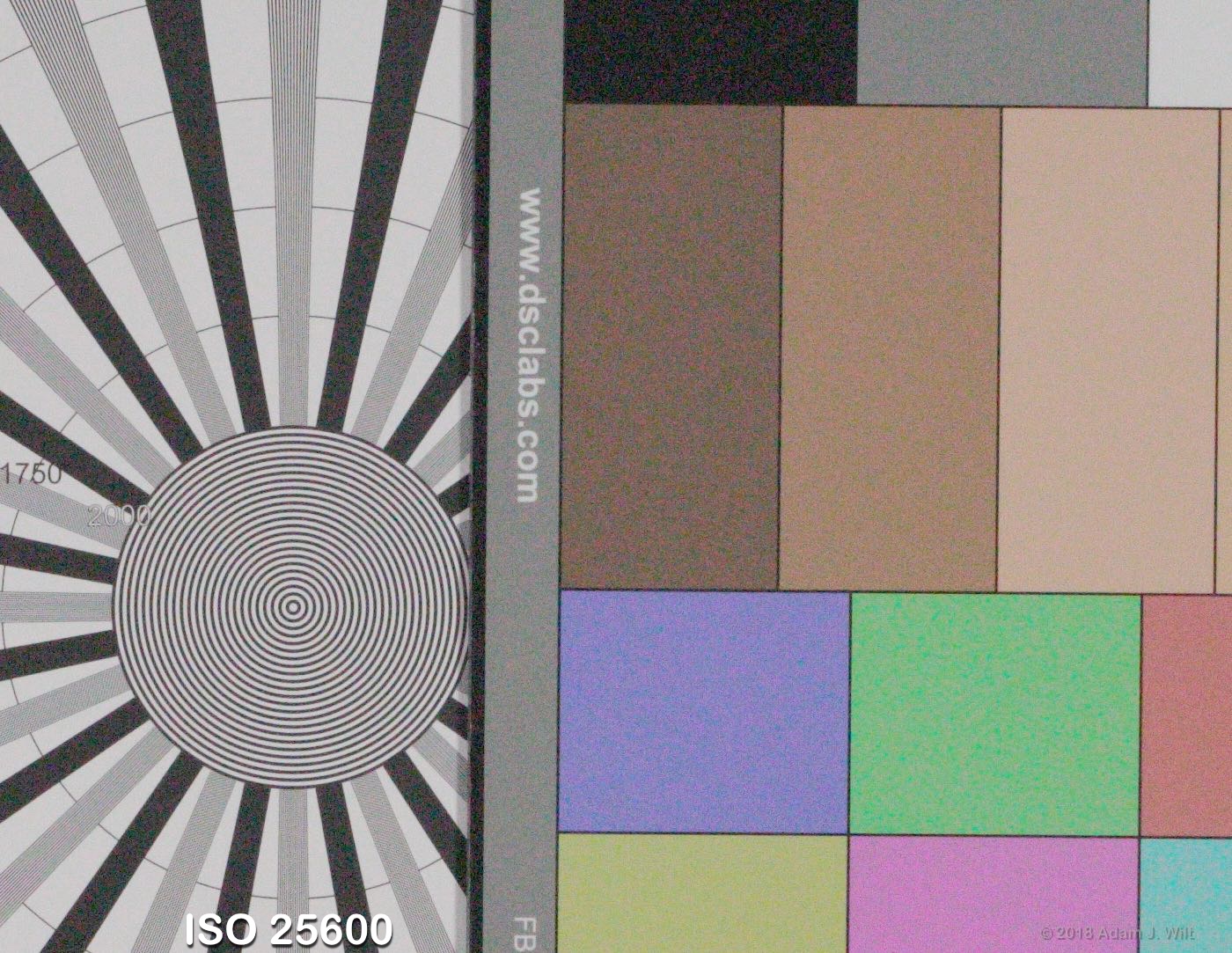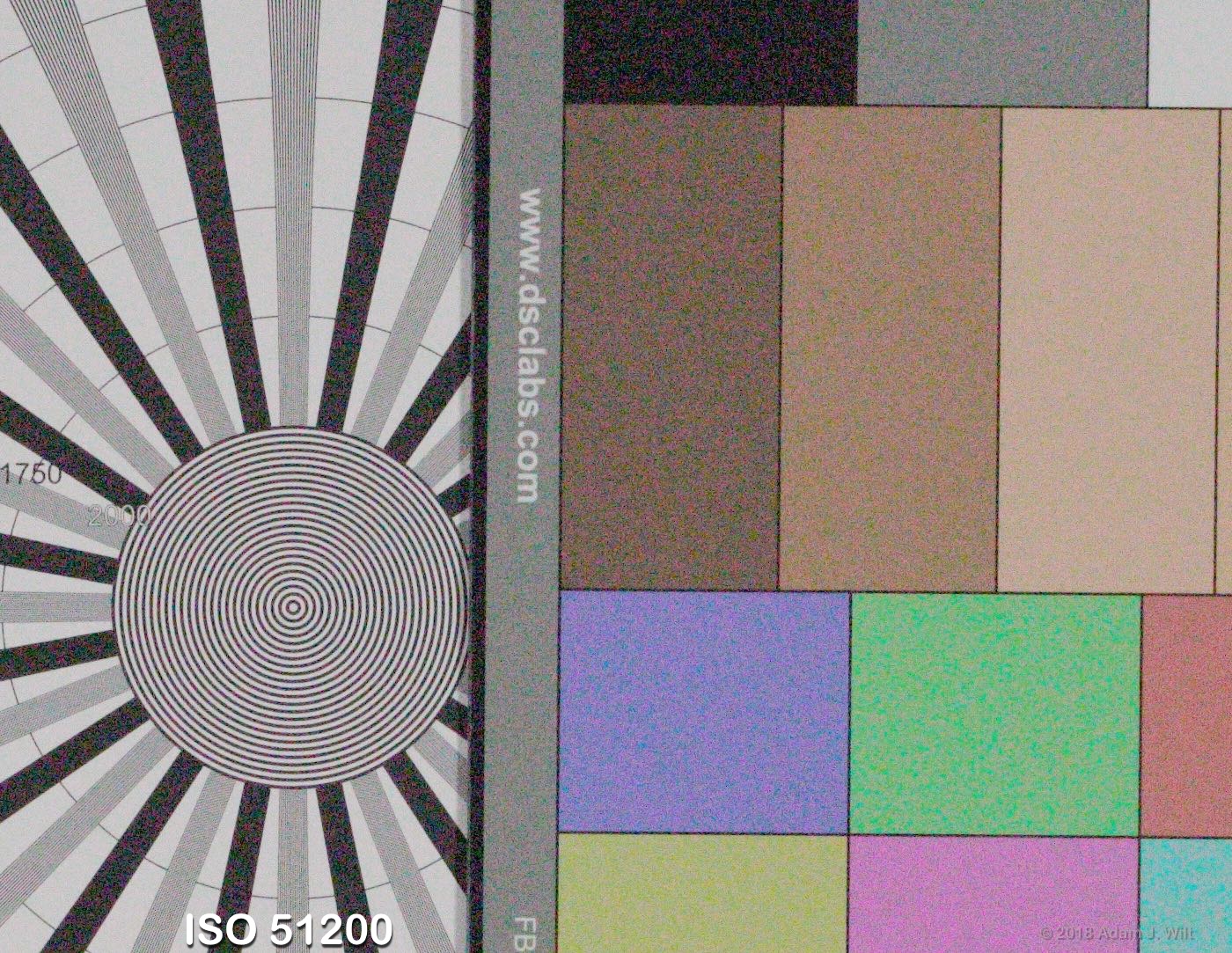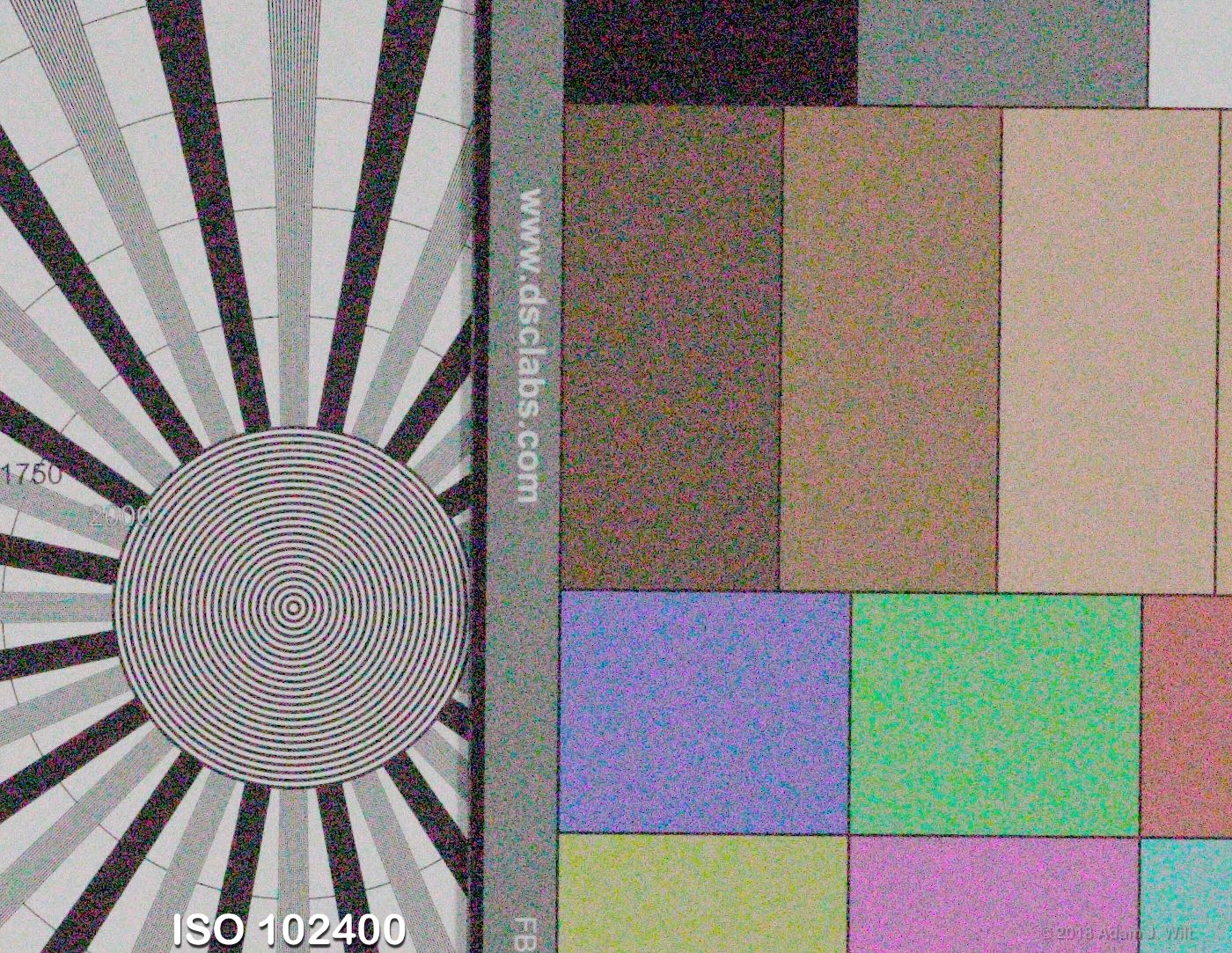[This is part 2 of a two-part review. Read part 1 here.]
Operation
For the most part, operating the C700 FF is unremarkable — and that’s a good thing. Controls are sensibly placed, require appropriate activation forces, and evoke sensible and predictable outcomes. In short, the camera stays out of your way and lets you get on with the job.
The camera starts up in about 25 seconds. Pressing and holding the power button starts a five-second countdown to shutdown, which takes a further seven seconds. Those aside, mode and settings changes are quick: under five seconds to change sensor mode (FF / S35 / S16) or frame rate, while switching recording formats takes between eight and fifteen seconds. REC button response is instantaneous.
Both the side panel and the EVF display offer a wealth of status readouts. The EVF’s onscreen displays can be turned off in the menus if you find them distracting, or you can assign a user button to toggle them on and off.
It’s possible to drive the camera entirely from the EVF. By default, the FUNC button highlights and cycles through frame rate, shutter speed, ISO/gain, and white balance settings, which you can then change using the control dial or the joystick without obscuring the image or moving your eye from the finder (if you’re using a third-party EVF, you can assign a user button on the body to replicate FUNC). It’s very quick, with no menu-diving needed.
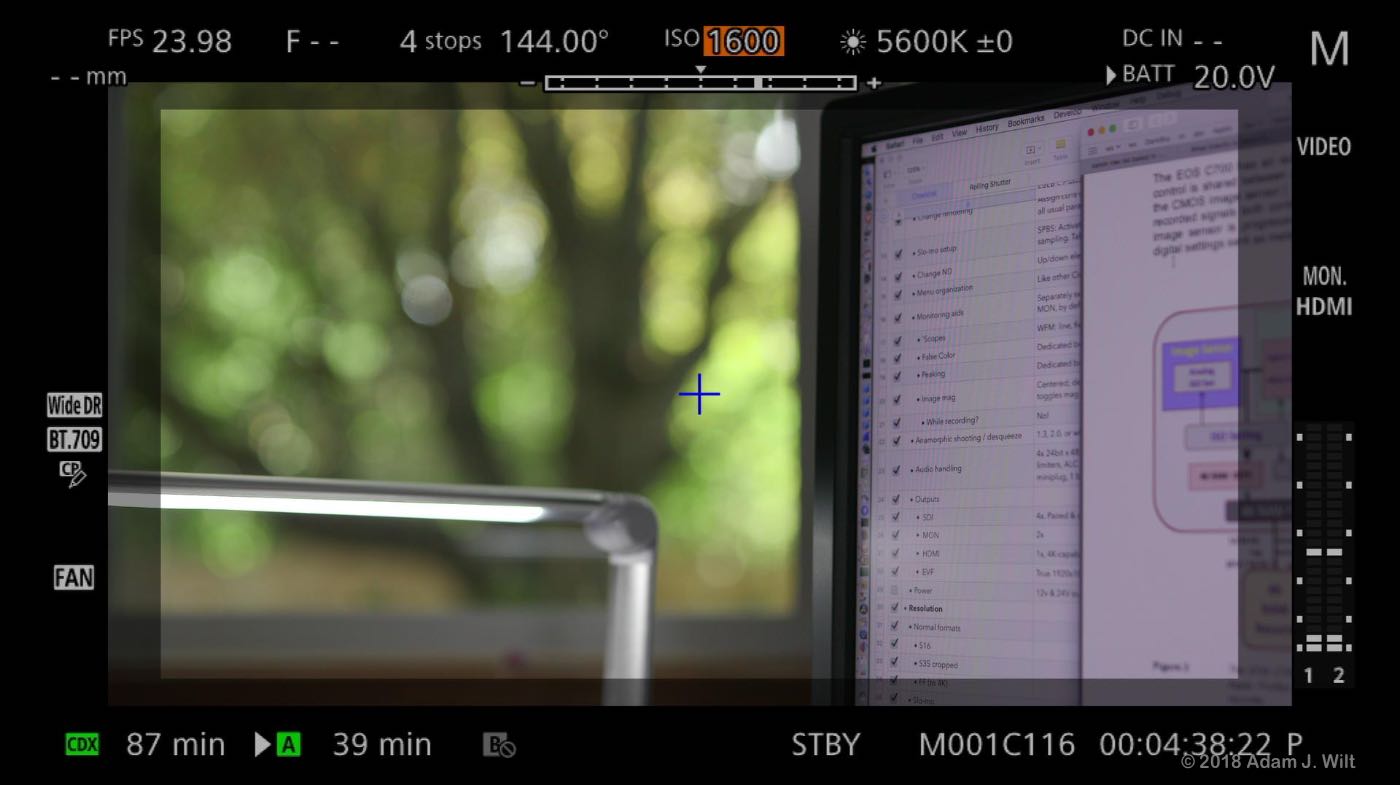
The EVF also has dedicated buttons for image magnification and false color (and these, along with FUNC and EVF, are reassignable if you prefer), making it quick and easy to check focus and exposure.
When not employed in menu navigation the EVF’s joystick moves the AF target area around (on EF cameras with EOS AF lenses) and repositions the zoomed-in image when using image magnification.
You can also drive the camera using the six-button side panel, a workflow that’s increasingly standardized across serious cine cameras. Most of the common operating parameters are there, either at the top level or perhaps one level down. If prefer twiddling the dials on the right side of the camera, the optional OU-700 remote replicates the side panel on a rotatable and dismountable panel.
True, audio setup is two levels down in the ALT screen, a potential issue if you’re a solo op — though running and gunning an eight-pound, $33K cine camera without benefit of a separate soundperson probably wasn’t a use case that Canon considered significant.
The side of the camera has dedicated (though reassignable) buttons for image mag, peaking, false color, and waveform monitor; that’s enough focusing and exposure assistance, immediately available, to assuage the fears of even a nervous-nellie operator like me.
Image magnification has two stages of zoom-in (3x and 6x in FF, 2x and 4x otherwise), triggered by pushing the SET button. While either MAGN. button, on the EVF or on the body, can be used to toggle image mag, only the SET button on the EVF toggles the zoom level — at least that was my experience with the EVF connected; I didn’t try unplugging the EVF to see it that allowed the body’s SET button to be used. By default, image magnification is only usable in standby, not while recording; fortunately you can change this in the menus. The magnified area can be panned around the frame using the EVF joystick or control wheel, or using softkeys in the side panel’s ALT > F. ASSIST screen.
If you’re using the EF camera, you also have Canon’s formidable dual-pixel AF and manual focus-assist functions. You can choose a large or small AF target area, move it onscreen using the joystick (and return it to screen center using a button), and select between one-touch AF, continuous AF, and AF-Boosted MF. AF-Boosted MF lets you manually focus the lens, then takes over when focus is close and makes it well-nigh perfect. You can also enable face-detection and tracking; set the response speed (how aggressively the focus will adjust when the focus point changes), and set the focusing speed when the lens allows that level of control.
Canon’s dual-pixel AF is highly reliable as long there’s enough light for the DPAF circuitry to make out detail to focus on. Focus moves smoothly in the proper direction, with little if any overshoot and no back-and-forth hunting. As far as I know, there’s no better AF available.
I found the false color function to be so clear and so useful that I rarely used the WFM or the zebra, but both are fully functional if you prefer them. The WFM is on the small side for detailed perusal, but it’s perfectly suited for quick exposure checks while shooting — and small enough to avoid covering too much of the picture while it’s displayed.
You can assign a button to capture a still photo on the SD card when in standby, making the C700 FF Canon’s most expensive full-frame still camera. Photos save at 2K or HD resolution.
Playback and management of clips and stills is straightforward. When viewing a clip, you have the usual transport controls: play, pause, step forward and back (stepping by frame, by one second, or by 10% of the clip, as you prefer).
I encountered one glitch in playback, where borderline-overexposed parts of a raw clip displayed as green:
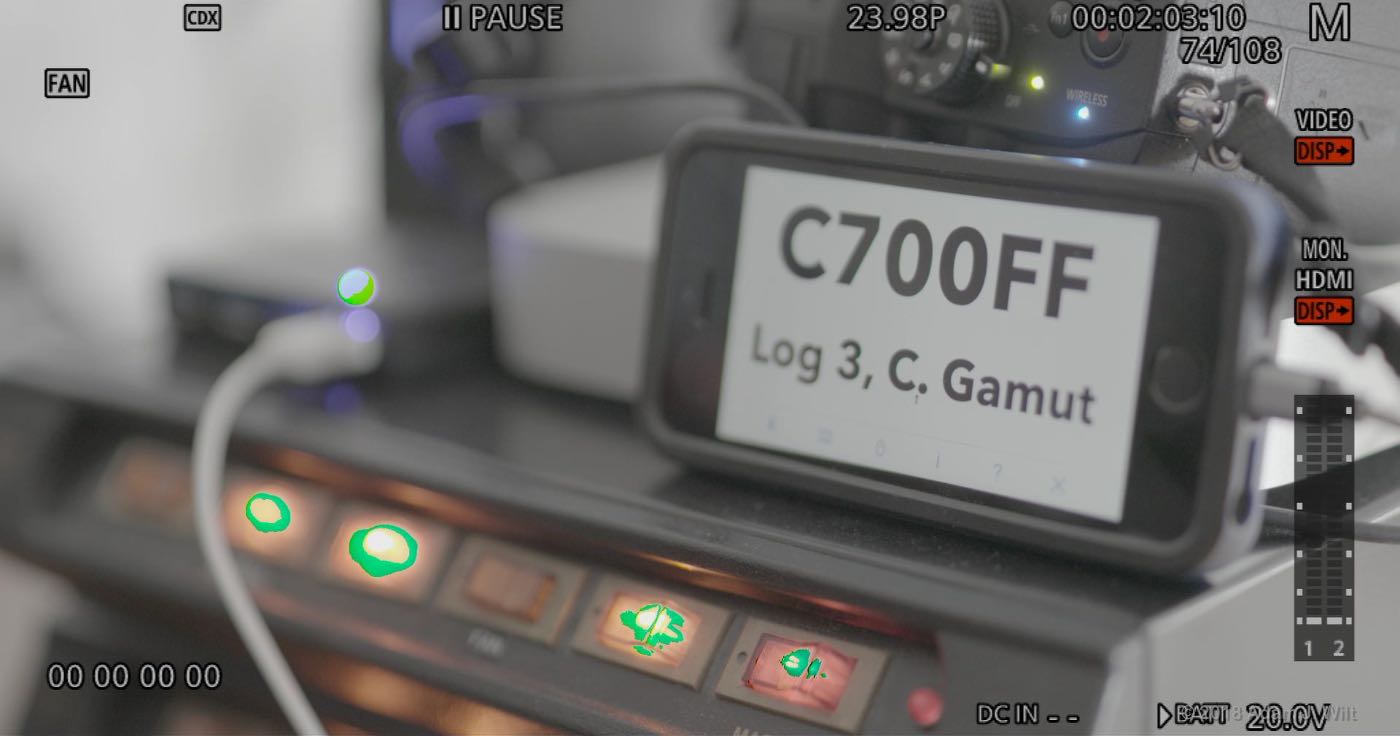 The clip itself is perfectly fine, and live view didn’t show the same green, but the on-camera playback did prompt me to pop the capture drive out and check the clip on my MacBook Pro before continuing. I don’t know if this was a one-off occurrence or an artifact of this early-firmware, much-abused demo camera; the Intertubes don’t proffer any other reports of such a thing, so I’m guessing it’s not a common problem.
The clip itself is perfectly fine, and live view didn’t show the same green, but the on-camera playback did prompt me to pop the capture drive out and check the clip on my MacBook Pro before continuing. I don’t know if this was a one-off occurrence or an artifact of this early-firmware, much-abused demo camera; the Intertubes don’t proffer any other reports of such a thing, so I’m guessing it’s not a common problem.
The only other operational issues I encountered occurred when switching the sensor between FF, S35, and S16 crop modes and when changing recording formats.
I previously mentioned the downsizing of my 4K sub record setting to 2K when I switched the camera into, then out of, S16 crop mode. I’d prefer it if the camera remembered the sub rec resolution setting on a per-mode basis so that this gotcha wouldn’t get you, but to be fair, any time you change sensor modes the camera warns you, “[t]he video configuration was changed. Check the settings.” I, however, neglected to check all my settings, and I missed that. It was a simple newbie mistake on my part, aided and abetted by the lack of sub rec resolution info on the HOME or INFO screens; I mention it simply so you can avoid making the same mistake.
Similarly, if you have sub recording enabled for raw main recording and switch the camera to record XF-AVC or ProRes, then switch back to raw, you’ll need to re-enable sub recording; the camera doesn’t remember that for you. Fortunately this is shown on the side panel’s HOME screen, as long as you remember to look at it.
When you select recording on the Codex, the camera sets the base frame rate (system frequency) to 59.94. If you choose ProRes on CFast, the camera switches to 29.97. If you select XF-AVC, the camera leaves system frequency alone. Again, you’ll see this on the HOME screen.
Just be sure to re-check all your basic operating parameters whenever you switch frame sizes or recording formats, and you’ll avoid unhappy surprises.
Yes, I’d prefer not encountering these sorts of surprises on a $33K cine camera — I’d rather the camera did a more thoughtful preservation of state with respect to frame sizes and formats, and didn’t change system rates on me without my explicit say-so. The counter-argument is that any competent camera crew working at the level this camera affords will re-check all these things as a matter of course. The counter-counter-argument is that even experienced operators can miss things in the 16th hour of a standard 12-hour day, especially when the camera system as a whole is otherwise so consistent, sensible, and surprise-free.
Oh, one more thing: when I received the camera, I performed a system reset to return the camera to its default state. The default state included Japanese menus! A frantic dive into the manual showed me the pathway to the language setting, which cleverly includes a little cartoon-voice-balloon icon to distinguish it from all the other settings. No harm done. The manual states that the default setting for the camera should be English, so I’m guessing this was an artifact of pre-release firmware (version 1.0.0.1.00) on my demo camera.
If neither English nor Japanese is to your liking, the camera also offers German, Spanish, French, Italian, Polish, Portuguese, Russian, Simplified Chinese, and Korean.
I didn’t have a shoulder-mount adapter for the C700 FF, so I didn’t use the camera off the tripod. I’ve briefly flown C700s at local trade shows; it’s a moderately heavy camera (eight pounds or 3.6 kg for the body alone) but a well-balanced one, quite capable of counterbalancing a heavy full-frame prime or short zoom with the Codex recorder and a battery on the back.
Resolution and Aliasing
The C700 FF’s 17×9 sensor has 5952 x 3140 photosites, about 45% more in each direction than a 4K-native sensor has. This plenitude of pixels allows for sharp, supersampled 4K images from the full frame, a Super35mm-sized 4K / UHD cropped image with 1:1 sampling, and a Super16mm-ish 2K / HD cropped image with 1:1 sampling.
In full frame, the sensor should be expected to resolve around 2350 to 2500 TVl/ph (TV lines per picture height, where a full cycle from light to dark equals two TV lines) in its 5.9K, pixel-for-pixel format, using the rule of thumb that the resolution you’ll get from a Bayer-pattern sensor is 75% – 80% of the raw photosite count. Super35 1:1 images can be expected to yield 1620 to 1730 lines, and Super16 half those numbers: 810 to 865 TVl/ph.
Using clips created from the raw files with Canon’s Cinema RAW Development app, I saw results very much in line with those predictions. (Lacking a chart exceeding 2000 TVl/ph, I framed that chart at half-size in my FF testing, so that actual numbers are twice those shown on the chart.)
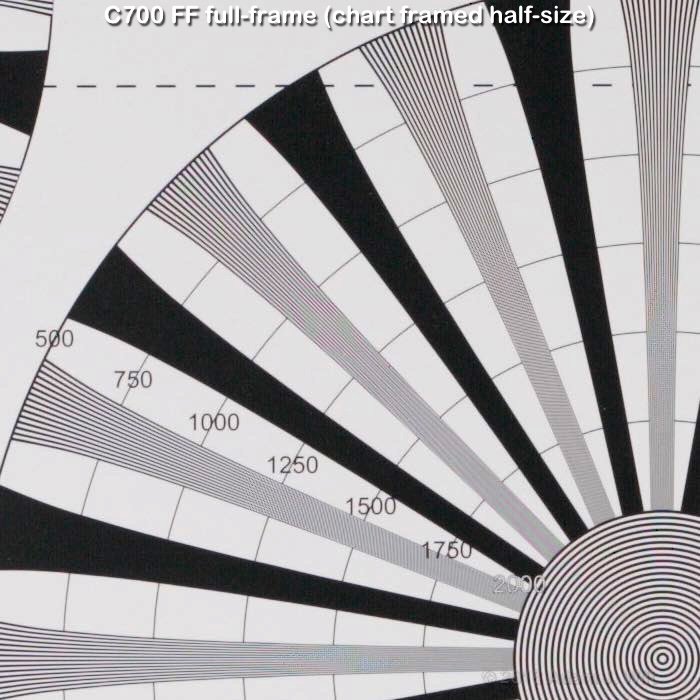
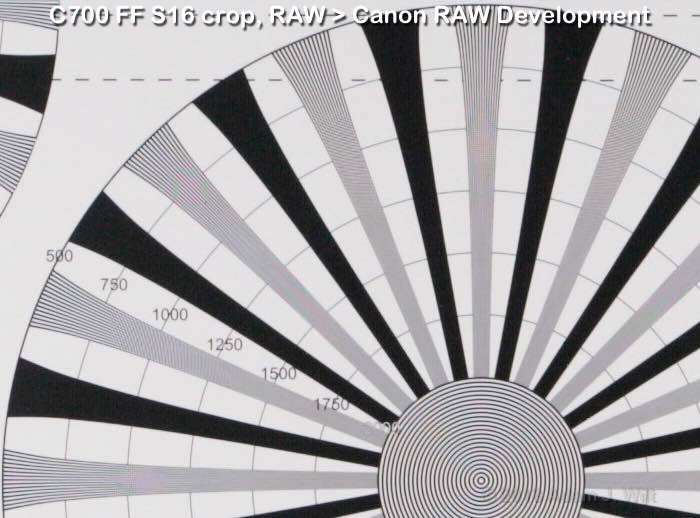
Various chroma and luma aliasing artifacts around and beyond the resolution limit are largely in line with expectations.
Downsizing the 5.9K image to 4K requires a non-integer scaling of 0.688x, resulting in a (roughly speaking) “five sharp, one blurred” effect in fine detail at the 2000 TVl/ph level, as the resizing unavoidably splits formerly-sharp lines across pixel boundaries:
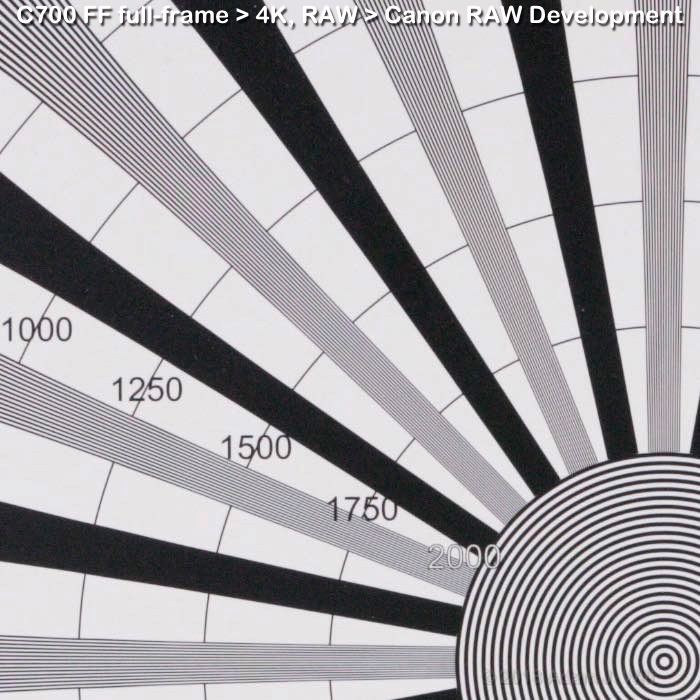 (In this image, the chart was framed normally, not half-size)
(In this image, the chart was framed normally, not half-size)
That effect is to be expected; the only way to avoid it would be low-pass filtering the picture so severely that any sharpness gains from supersampling would be eradicated. In any event, it’s only an issue shooting fine, high-contrast repeating detail, like test charts — if you’re shooting real-world imagery, it’s unlikely to appear, and it’s still cleaner than the same fine detail captured with “only” a 4K imager.
In short, the C700FF does as well as any other single-sensor camera in its pixel-for-pixel S35 (4K/UHD) and S16 (2K/HD) modes, while its full-frame 5.9K captures allow for superior 4K images compared to native 4K captures.
Of course, that 45% “oversized” full-frame capture also lets you extract an S35mm-sized 4K image, pixel-for-pixel, from the full frame. You have plenty of room for image stabilization, straightening, and reframing, should you so desire, as well as the ability to “zoom in” in post some 30% or so without a telltale loss of sharpness.
None of this should come as any surprise: the C700FF reads each and every active photosite of its imager and combines them in thoroughly conventional ways to yield high quality images. So far, so boring, as it all could have been predicted from the basic specs of the sensor.
What is interesting is that these same results hold down to the finest detail (pun intended) in Slow & Fast recording. The C700FF does not appear to line-skip, pixel-bin, or take any other shortcuts scanning the image when operating at unusual frame rates. S&F clips shot at high frame rates look exactly like the normal frame rate stuff does. The C700FF may not match the high frame rates of some of its competitors, but its image quality is never compromised in the quest for speed. If the camera can shoot it, it’ll look just fine.
Compressed clips are slightly softer than raw clips; they appear to have a certain amount of low-pass filtering applied. While they achieve the nominal resolutions expected, they tend to blur rather than alias at higher spatial frequencies, and they show more chroma moiré around and above the Nyquist frequency.
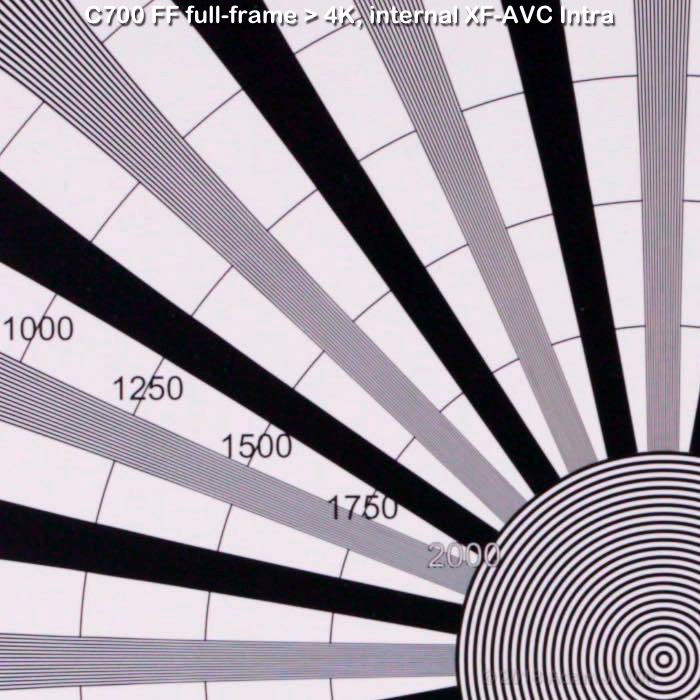
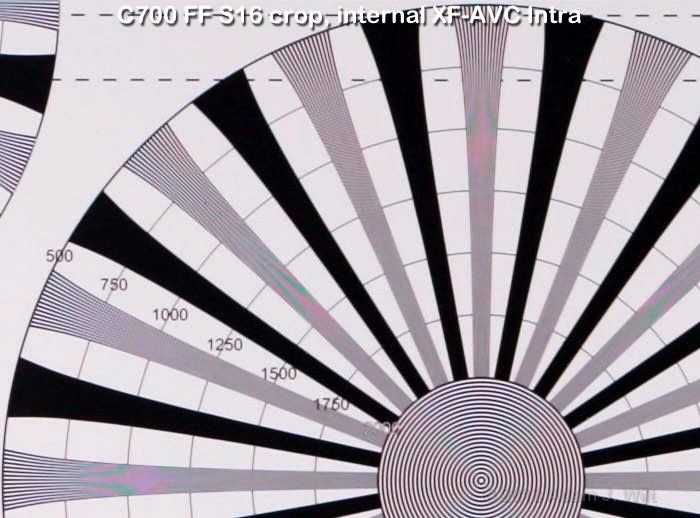
Don’t worry, this sort of thing is to be expected. The VariCam LT shows a similar raw-vs-compressed difference, as do other cameras. Pre-filtering is often used to reduce compression-aggravating high frequencies, and the sharp, contrasty transitions on a black and white resolution chart show these differences far more than real-world images will. In practical production, Canon compressed pix are just fine; still, if you want the ultimate in quality, record raw on the Codex.
The compressed clips also show a slight magenta tint compared to raw clips shot at the same time. I don’t have a good explanation for this, sorry; I’m as puzzled by it as you are.
I shot the same chart using both XF-AVC and ProRes as the main codec, and using XF-AVC as a sub record while shooting raw, and all three compressed clips were visually identical. The same in-camera processing is applied regardless of the compressed recording format.
Tone & Color
Canon offers a variety of tonal scales, color gamuts, and matrices for XF-AVF and ProRes recordings. Page 135 of the manual lays out the tonal scale and gamut choices more concisely than I could:
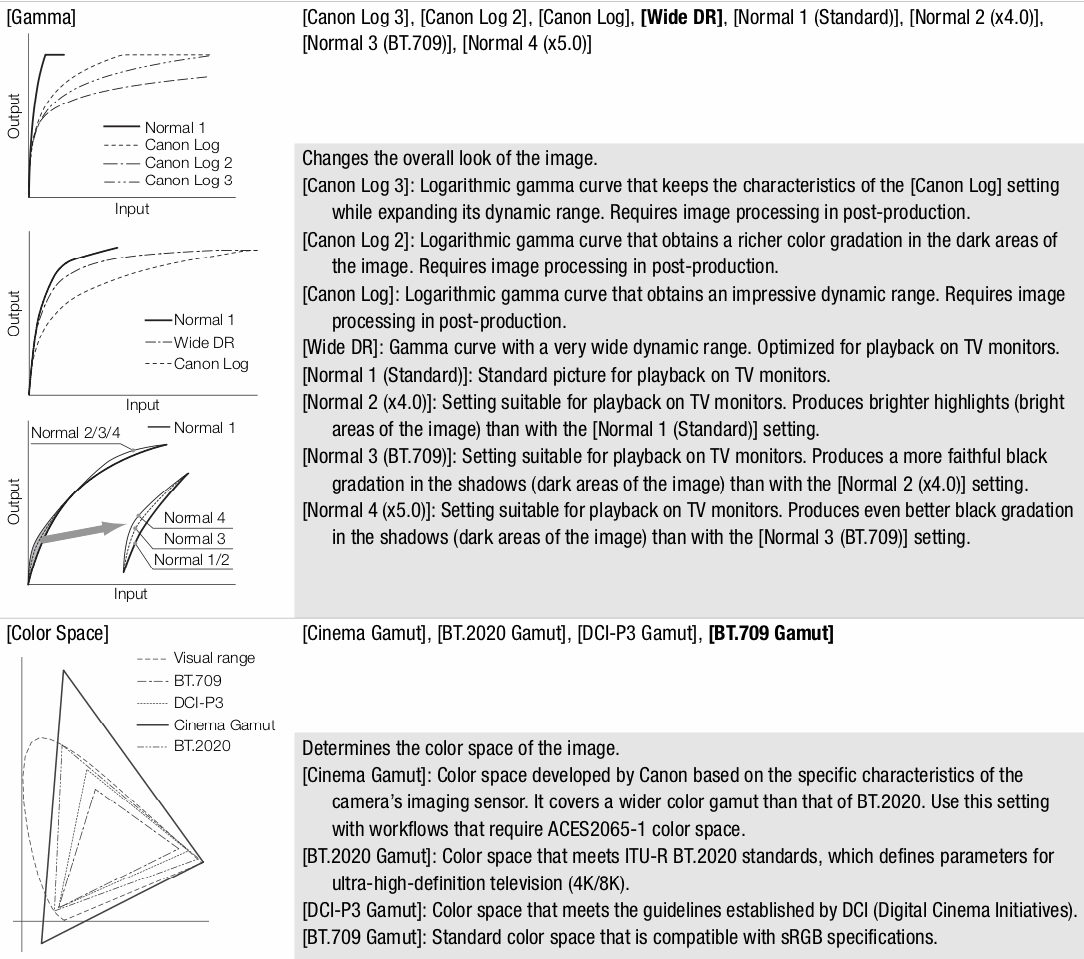
Here’s how the different tonal scales compare (of the “normal” gammas, I only show Normal 3, BT.709). I’m using a DSC Labs Cine-ChromaDuMonde chart, with an 11-step gamma-coded grayscale ramp and a smooth, logarithmic grayscale ramp:
Both Log and Log 3 apply a fair amount of shadow compression to minimize noise, while Log 2 preserves the log curve all the way down.
Wide DR is a 709-like curve below about 55% with an S-curved highlight compression above that point, not unlike a Sony Hypergamma or (dare I say it?) ARRI’s 709-like gamma. It handles overexposure more gracefully than the normal curves with their conventional knees, with less dramatic hue shifts prior to clipping and the ability to hold onto darned near the entire dynamic range the camera is capable of (more on this below).
Canon offers the following matrix choices:
- Neutral: Reproduces neutral colors.
- Production Camera: Reproduces colors more suitable for motion picture production.
- Cinema EOS Original: Color matrix developed by Canon, designed to reproduce the 4K output of an EOS C500 camera using the BT.709 color space.
- Video: Reproduces the colors of an EOS C300 / EOS C500 camera with no custom picture settings applied.
- Off: Colors are not adjusted.
Here’s what they look like:
Canon colorimetry is widely considered pleasing, especially on skintones. I didn’t have the opportunity to shoot any proper tests outside my office/studio, but the C700’s color rendition with the limited subjects I had available was both accurate and attractive in all but one case: shooting a couple of highly-saturated blue LEDs.
Two blue LEDs in a USB hub and a drive dock, or surfaces illuminated by them, had a tendency to veer toward purple. Meanwhile, a similar blue LED in a GH5 camera showed no such tendency; it rendered exactly how it looked (my Lighting Passport spectrometer measures the offending LEDS at 454nm, while the GH5’s LED emits blue at 469nm). This anomalous purpulation appeared in all gammas and in all raw exports (Codex ProRes VFS, Codex generation, and Canon RAW development).
For what it’s worth, a Canon 80D DSLR in live-view mode showed a similar rendering, but three different Sonys (A6300, A7ii, A7Riii), two different Panasonics (GH4, GH5), an Olympus E-M10 II, and a Fujifilm X-T100 rendered that blue correctly.
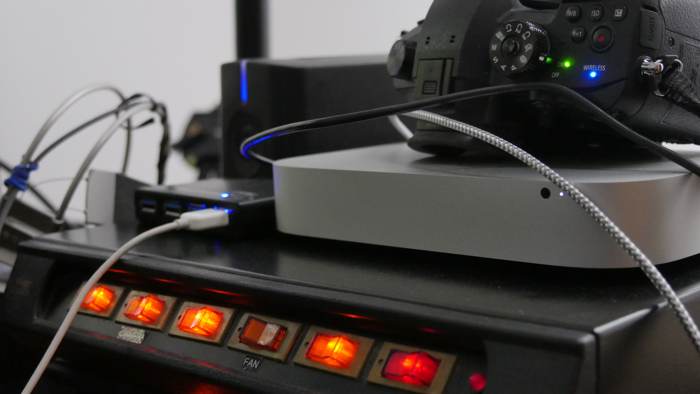
This appears to be a peculiarity of Canon’s color science confronted with a saturated, narrow-band blue. When I used Canon RAW Development to open the raw clip and fiddle with the white balance, I could restore that purple’s true color when the color temperature was set to 9000 K or above; conversely, I could flip the GH5’s LED to purple at color temperatures below 2900 K. Meanwhile the rest of the scene got bluer at lower white balances and yellower at higher ones, just as you’d expect.
I don’t consider this a showstopper as it’s an unusual corner case, but it’s something to be aware of.
ISO / Gain
While the C700FF’s base ISO rating (e.g., a gain of 0 dB) is 200, Canon says the minimum setting “to obtain the recommended dynamic range” is 400 in Canon Log or Wide DR modes, or 800 in Canon Log 2 or Canon Log 3. Looking at the waveform monitor while shooting a DSC Labs Xyla 21 chart explains this odd recommendation. With the camera displaying Log 3 and the chart exposed so that the brightest two bars clip at the same point, that clipping occurs at about 78% for ISO 200, 89% for ISO 400, at 100% (Log 3’s full-scale maximum value) for ISO 800 and above: the sensor saturates before the full range of encoding values is exploited at ISOs below 800.
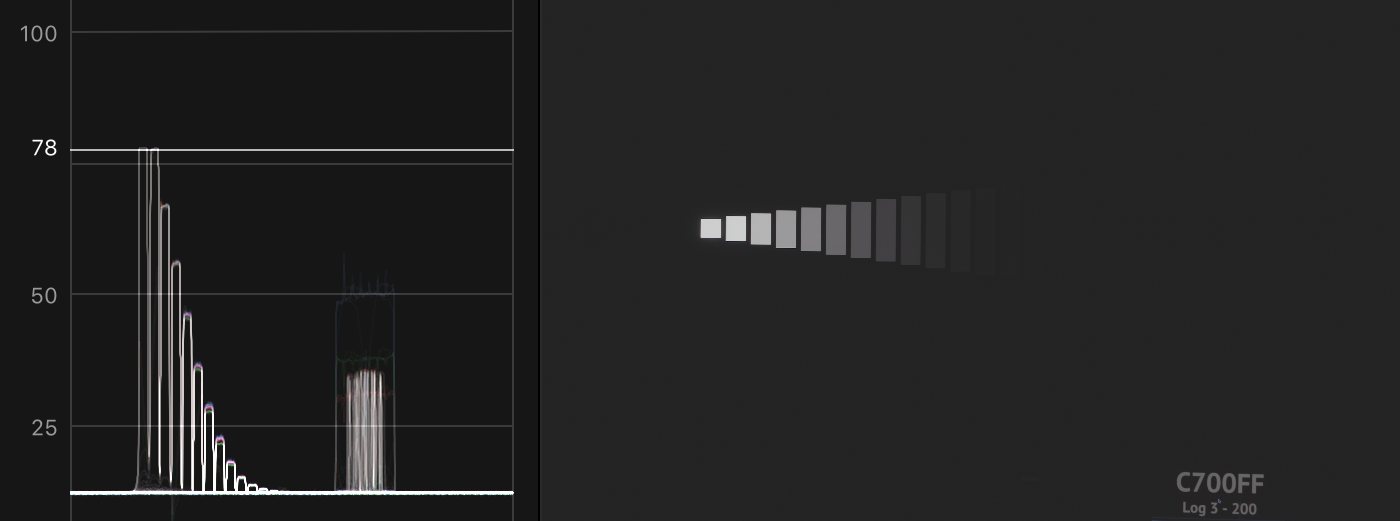
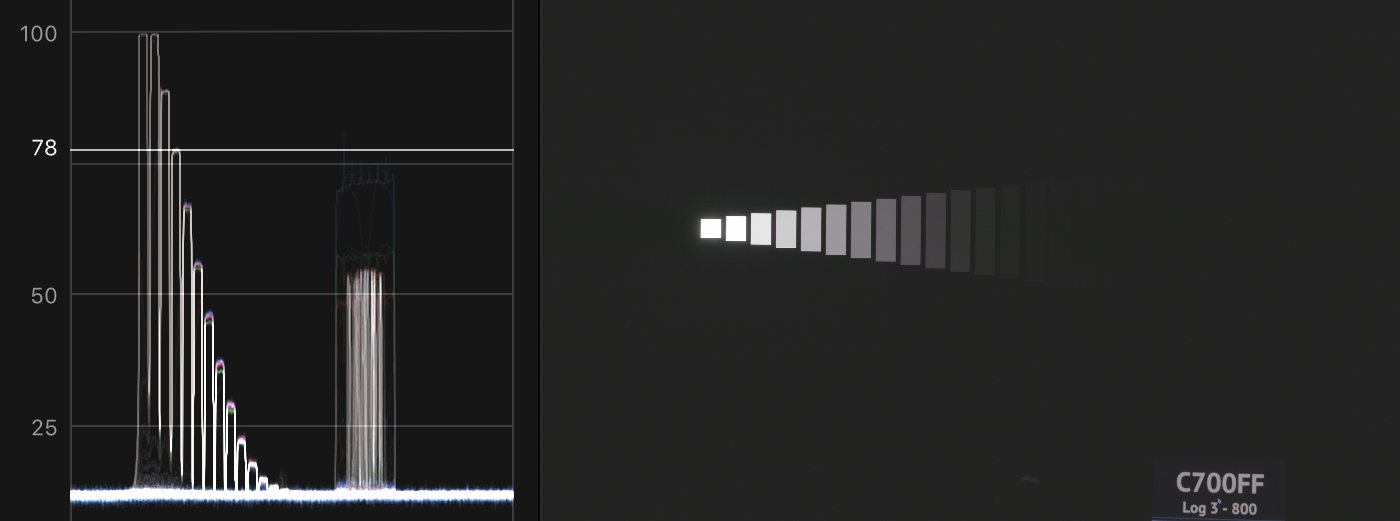
(If you don’t have a Xyla, you can see the same thing by observing that nothing in a scene exceeds 78% at ISO 200 when monitoring in Log 3, regardless of how wide open the lens is or how bright a specular or light source you’re shooting. Set the camera to ISO 800, and you can hit 100% with ease.)
With the camera set instead to its BT.709 gamma, you can hit 109% (709’s full-scale maximum) at ISO 200, since BT.709 encoding has two stops less headroom. And, as advertised, Canon Log (original) and Wide DR can max out their tonal scales at ISO 400, while Logs 2 and 3 don’t hit their full scales until ISO 800.
That implies that BT.709 gamma has two stops less dynamic range than Logs 2 & 3, while Log and Wider DR have a stop less; and for each stop lower ISO than the recommended value you’ll see one stop less DR using Wide DR or Log encodings. That’s mostly correct, though what you lose off the highlights is somewhat recovered in the shadows, depending on the encoding: a lower ISO or gain may prevent the full range of encoding from being utilized, but the lowered noise can allow a deeper dive into shadow detail.
The normal ISO range is 160 – 25600 (-2 dB to 42 dB) with an extended range of 100 – 102400 ISO (-3 dB to 54 dB). The extended range is “outside the recommended range but can still be used”; on the low end you’ll lose a bit of headroom while on the high end the noise gets more dramatic.
The camera does an excellent job of preserving the picture as gain is boosted. Yes, noise levels increase, but both fine detail and color are retained with remarkable consistency, in XF-AVC as well as in raw. (These samples are 1400 pixels wide, so you may want to save ‘em locally for pixel-peeping. I accidentally bumped the focus for ISOs 1600 and 3200, so those two pix show softened detail and purple CA on the res chart; these are focusing artifacts and are not inherent in those two ISO settings.)
The C700FF’s raw recording “bakes in” ISO, but unlike the C300 Mk II, it does not bake in color gamut or white balance. Canon uses “the maximum digital coding regardless of the ISO setting”, so that even at ISO 200 the full digital range is used in the .rmf files. When the raw is “developed”, it presents itself as a Canon Log 2 / Cinema Gamut / Neutral matrix image, ready for further grading.
Dynamic Range
Canon rates the camera’s sensor at 15 stops of dynamic range. TL;DR version: yeah, you get that; they’re telling the truth. You can skip to the next section if all you care about is the big number (grin).
I did the usual tests of throwing Xyla 21 clips on a timeline and then pulling and pushing the tonal scale around with color-corrector controls to see how deeply I could see into the shadows. I counted the number of one-stop steps from clipping down to the last step clearly separable from shadow noise to get a dynamic range number.
(Note that my criterion for the lowest visible stop is different from Canon’s: Canon stops counting at the point where a stop’s change is equal in magnitude to the background noise. Canon’s criterion is slightly more conservative, so my numbers may exceed Canon’s by a small amount.)
Note that this doesn’t always indicate the number of stops you’ll cleanly and comfortably get, especially if you’re averse to seeing any noise in the finished image; both my numbers and Canon’s are measures of technical limits, not guarantees of suitable performance levels. Art Adams likes to differentiate between “paycheck stops”, those you need to get, or your paycheck stops; and “gravy stops”: any stops beyond those you have to get are gravy. Depending on your noise sensitivity, your “paycheck stops” may be somewhat lower than measured numbers would imply; you may prefer to crush the shadows to reduce noise, crushing the last stop (or two, or three) in the process.
With those caveats in mind, I did indeed see 15 stops in Logs 2 & 3 at ISOs 800 and 3200; 14 at ISO 12800; decreasing to “only” 10+ stops at ISO freakin’ 102400.
Note: Canon’s “Deep Dive” white paper says that the lower two stops available in Log 2 are not available in Log 3. That’s not what I saw: they’re compressed more by the “toe” of the Log 3 curve, but apparently there’s enough of a “dither signal” added by the noise to boost them into visibility.
I wondered whether I had perhaps had too much ambient spill in my room when I did my test: light emitted from the Xyla might have bounced off the white walls and “bias lit” the chart, raising black levels enough for me to see a stop or two farther into the shadows than I should have. I repeated the test in Burbank, blacking out Canon’s test bay completely to avoid this problem. I got identical results.
Wide DR gave me 15 stops through ISO 3200, 14 at 12800, declining finally to around 10 at ISO 102400.
In Canon Log, I saw 12 stops at ISO 200, 13 at ISOs 800 and 3200, and 10 at 102400.
BT.709 gave me 13 stops through ISO 3200, then fell off to 10 stops at ISO 102400. I had the default knee set up for BT.709; it’s possible I could have eked out more DR with a more aggressive knee.
All in all, these are highly respectable numbers for a modern camera, and especially impressive at higher ISOs.
Rolling Shutter
The FF uses a rolling-shutter sensor (if you don’t like it, there’s a C700 GS PL with a global shutter, but it’s not full-frame). To see how severe it is, I set up my usual test: a perfectly vertical light stand against a black backdrop. I dialed the shutter speed to 1/2000 to minimize blur, and panned the camera past the stand in both directions. In post, I used a T-square to measure (a) the different lateral positions of the top and bottom of the stand in a frame and (b) the different positions of the stand at the top of the frame in two subsequent frames.
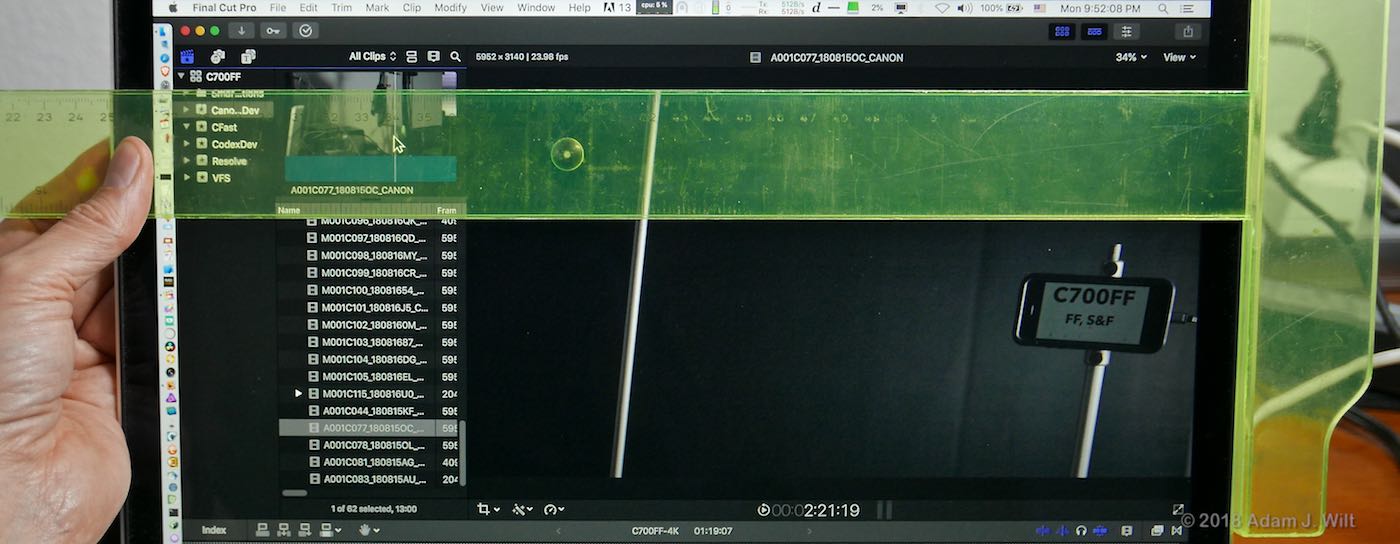
The ratio of the two differences multiplied by the total frame time (the inverse of the frame rate) gives the rolling shutter time; averaging multiple measurements reduces errors due to sloppy measurements and inconstant panning speeds. All the resulting measurements should be accurate to within roughly +/- 5%.
- Full-frame: 1/63.5 sec
- Full-frame, widescreen: 1/84 sec
- S35 crop: 1/92 sec
- S16 crop: 1/191 sec
I re-ran the tests in Slow & Fast recording mode, and got the same answers: the camera isn’t scanning the sensor any differently in S&F mode.
Conclusion
The C700 FF is a highly capable full-frame cine camera focused on consistency and image quality. Combined with the docking Codex recorder, it captures 5.9K raw images as easily and effortlessly as it records XF-AVC or ProRes, and with the same range of frame rates. The camera also offers S35mm and S16mm crops, with native 4K/UHD and 2K/HD resolutions respectively.
The C700 FF lets you shoot raw or log, with a full complement of built-in monitoring LUTs. You can also choose from a variety of video gammas and use a comprehensive set of video-style adjustments for images with a “baked in” look.
You can shoot either XF-AVC Intra or ProRes at 4K/UHD or 2K/HD resolutions; both codecs capture 10-bit 4:2:2 data at all frame sizes, with 12-bit 4:4:4 RGB options in 2K/HD modes. You can sub record 4K or 2K XF-AVC Intra clips while recording raw, or XF-AVC Proxy clips while recording any main format.
The camera offers a reasonable selection of slow & fast frame rates; it may not have quite the range of some other cameras, but its S&F images are always fully sampled without line skipping or pixel binning, and so preserve full quality regardless of frame rate.
By the same token, image resolution and color rendition are remarkably consistent across the range of ISO/gain settings available: yes, noise increases at higher gains, but that aside there’s nothing to prevent you from intercutting ISO 200 and ISO 6400 shots.
The camera captures a solid 15 stops of dynamic range, and has Canon’s well-regarded colorimetry.
Operations and menus are sensible straightforward and (mostly) without surprises, though it behooves you to re-check system frequency, frame rate, and sub recording settings whenever you change sensor modes or recording formats — just as you need to do with any other multi-format, multi-resolution camera.
A superb (if pricey) full HD OLED EVF provides a clear view of the camera’s image and status and provides a well-designed set of controls. Dual monitoring outputs can carry the same data for separate monitors or third-party EVFs. Image mag, peaking, zebra, false color, and waveform monitor functions keep you on top of exposure and focus concerns.
An industry-standard six-button side panel lets you drive the C700 FF the same way you’d drive an Alexa, F55, or VariCam. An optional remote can be added to the right side of the camera, replicating the left-side panel.
Video-style CCUs may also be connected for remote shading, and the camera has both timecode and genlock/sync terminals for multicam work.
The EF-mount version offers Canon’s full gamut of dual pixel autofocus and manual focus enhancements, including tap-to-focus using Browser Remote over wired or wireless networks.
At $33K for the basic body, $7000 for the Codex recorder, and $6000 for the EVF, the C700 FF isn’t exactly cheap (though other full-frame cine cameras aren’t, either). But it is a solid, consistent performer, offering high-quality, 15-stop, 5.9K full-frame raw images as well as 4K and 2K compressed pictures, and doing so in a camera-crew-friendly form factor. For the C700 FF’s intended market, that focus on image quality, predictable performance, and usability is what really matters.
Pros
- 5.9K full-frame sensor with S35 and S16 crop modes.
- Dockable Codex recorder for fully integrated raw recording.
- 15 stops of DR, with Canon colorimetry.
- Camera-crew-friendly design with six-button side panel.
- No-compromise performance in Slow & Fast recording.
- Consistent color and detail even at absurdly high ISOs.
- Built-in ND filters.
- Both XF-AVC Intra and ProRes 10-bit 4:2:2 recording at 4K and 2K; 12-bit 4:4:4 recording at 2K.
- Great selection of focusing and exposure monitoring aids (image mag, peaking, zebra, WFM, false color).
- EF model has dual-pixel autofocus and manual focus-assist features.
- Multiple monitoring outputs, both SDI and HDMI.
- Sub recording capability.
- LUT support for monitoring and proxy recording.
- Sensible menu structure.
- Four channels of audio recording.
- Full HD OLED EVF with multiple controls.
- Network connectivity for remote monitoring/control, IP streaming, and FTP proxy transfer.
- Timecode and genlock I/O for multicam production.
- Anamorphic desqueeze.
Cons
- Compressed recordings are slightly softer and have more chroma aliasing than raw recordings.
- Unusual colors may not render properly in all circumstances.
- No viewfinder surround (lookaround) area in FF or S16 modes.
Cautions
- PL mount version lacks all the focusing enhancements of the EF version.
- Switching sensor mode or recording format can change system frequency and sub recording in unexpected ways; check all important operating parameters after making such a switch.
- Poor realtime audio level control.
- Image mag while recording is disabled by default.
Bottom Line
- A full-frame, highly flexible, crew-friendly cine camera that just works, giving clean, consistent imagery across a wide range of frame sizes, frame rates, and gain settings.
Disclosure: Canon supplied a C700 FF, Codex recorder, and Tokina prime lens for this review. Canon also covered the cost of my travel and lodging to visit their Burbank facility, both to test the C700 FF EF and to give a presentation to Canon folks about camera testing. Those aside, there is no material relationship between me and Canon. Canon did not compensate me for reviewing the camera, and the travel cost reimbursement was not conditional on a favorable review.

Filmtools
Filmmakers go-to destination for pre-production, production & post production equipment!
Shop Now